

How to Visit the Stockport Air Raid Shelters
Beneath Stockport, near Manchester, England is a mile of tunnels that could once provide shelter for 6,500 people.
The subterranean network was dug out from the sandstone in 1938. During the bombing raids by the Germans in the Second World War, the tunnels proved invaluable.
Now, 80 years later, one shelter known as the ‘Chestergate Hotel’ (due to the conditions being better than the average air-raid shelter) is open as a museum.
Visitors gain insight into the lives of everyday citizens of the 1940s, as their homes were bombed above their heads.
History of Stockport Air Raid Shelter

In September 1941 the Germans began bombing Great Britain from the air, in a sustained attack known as the Blitz.
While London bore the brunt of the campaign, many other cities across the UK were targeted. In Manchester, 8,000 homes were destroyed along with many of the city’s landmarks and industrial areas.
In nearby Stockport, the British were able to build their biggest civilian air-raid shelter.
The soft sandstone was suitable for tunnel building, and furthermore, the job was made easier due to the preexisting old cellars and mine workings that had been discovered a few years earlier.
With established access points close to the River Mersey, the government decided on an enlargement plan to turn the network into public air raid shelters.
Several large shelters were built in late 1938 and 1939, with the aforementioned Chestergate, (originally accommodating 3,850 people) being enlarged to take 6,500.
The conditions that led the shelter to become known as “the Chestergate Hotel” included good natural ventilation, electrical lighting, chemical toilets, bunk beds, and a canteen.
The large size was also extremely atypical. This led to higher levels of social life and communal support that gave citizens a greater feeling of security.
The popularity of Chestergate led to problems, however. The demand for places inside the shelter was high, and a shelter ticket system had to be introduced.
Credit needs to be given to the civilians and shelter marshals of the time mind you. Apparently there was never any conflict in the shelters during the war and the marshals would always find room somewhere in the tunnel system for those that turned up.
- Related Content: Oradour-sur-Glane: A Nazi Massacre Frozen in Time
Turning the Shelter into a Museum

After the war, the Stockport Air Raid Shelters were boarded up and abandoned.
They sat, almost forgotten for the best part of 50 years, only being re-opened in the mid-1990s, when workmen broke into the network while carrying out road repairs.
The tunnel system was in surprisingly good condition. The steel bunk beds had survived, along with the chemical flushing toilets. Many of the original features and of course the overall layout remained intact.
It wasn’t long before a proposal to turn the shelters into a visitor attraction was given the go-ahead. In fact, the Stockport Air Raid shelters became the first purpose-made shelters to be opened to the public.
The museum now has over 50,000 visitors a year and is one of Stockport’s top tourist attractions.
- Related Content: Visiting Wolf’s Lair – Hitler’s Bunker Complex, Poland
Where is the Stockport Air Raid shelter?
- Address: 61 Chestergate, Cheshire, Stockport SK1 1NE, United Kingdom
- Phone: +44 161 474 1940
Visiting the Shelters Today
A visit to the Stockport Air Raid Shelters provides an extremely interesting insight into life underground during WW2.
Inside the shelter, you will learn about the experiences of local people during the war. Informational displays line the tunnel walls with photographs from the times and items that would have been used while people took shelter from the bombing.
State-of-the-art audio-guides also provide commentary as you walk through the network.
Proceeding further into the tunnels and you will see the original sections of the shelter that remain. It is quite the sight to see the countless rows of bunk beds and larger, open plan areas where people would have socialized as they wondered whether their own homes were being destroyed above ground.
- Related Content: The Third Tunnel of Aggression
Urban Exploring

Shelters that exist at Brinksway and Dodge Hill remain closed and abandoned and are not part of the museum experience. However, Urban Explorers have found ways of getting inside these, and details can be found quite easily elsewhere on the internet.
Featured Image: Holiday Gems , CC by 2.0
How to Visit Grytviken Whaling Station, South Georgia

The Romanov Execution and Burial Sites

Visiting Iwo Jima – WW2 in the Pacific

The Museum of Underground Prisoners [Trips to Jerusalem]

Follow us on Instagram!
I have an insatiable wanderlust for the extraordinary. Born with an adventurous spirit, I have spent over the past decade exploring the far reaches of our planet, seeking out the strange and mysterious.
Leave a Comment Cancel reply
You must be logged in to post a comment.
Privacy Overview
Privacy Policy - Contact - Terms and Conditions
Experience the Blitz spirit at Stockport Air Raid Shelters
Stockport, greater manchester.
See how Britain survived the Blitz as you negotiate this dark labyrinth of tunnels at Stockport Air Raid Shelters.
It’s hard to imagine how frightening it must have been to experience a real air raid but the Stockport Air Raid Shelters give you a bit of a glimpse. Those confident of not losing their way can explore this labyrinth of tunnels at their leisure and take in the network of narrow passageways, carved out of sandstone cliffs, which once provided a refuge for 6,500 of Stockport’s inhabitants.
Alternatively, there are guided tours where you’ll discover the stories behind the tunnels and those they protected or, for the very brave, there are night-time explorer expeditions, where the shelters are darkened so you can really experience what it was like surviving the bleakest days of the Blitz.
- Find out more about Stockport Air Raid Shelters and plan your visit
- Find more heritage attractions in Manchester
Refine your search:
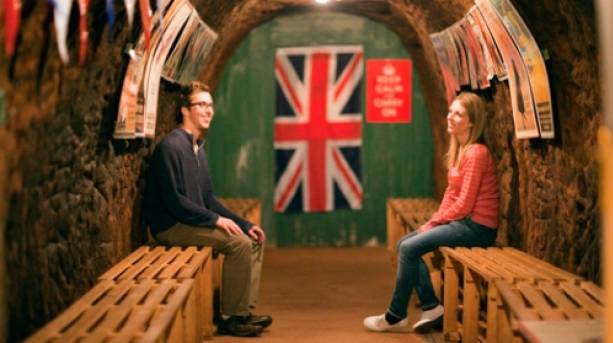
You may be interested in...
Discover England’s home of football in Manchester
Experience the history and drama of the nation’s favourite sport on a Manchester United Museum and Stadium tour, and at the National Football Museum.
Location: Trafford, Greater Manchester
Rainy Day Activities: Get hands on at the National Football Museum
Explore the world's largest football collection, learn about the history and culture of England's national sport and take part in other footy-related indoor activities at Manchester's National Football Museum.
Location: Manchester, Greater Manchester
Get the inside story on Manchester’s music scene
See the sights of the city that inspired Manchester’s legendary music scene and made it the envy of the world, with Manchester Music Tours.
Indulge in a romantic city break in Manchester
Your romantic getaway is just round the corner; visit some of the city’s most sumptuous hot spots for great cuisine and spectacular skyline views.
We've something we want to share
Want to receive travel tips and ideas by email?
VisitEngland would like to invite you to take part in a short survey about our website, it should take no more than a couple of minutes.
Go to the survey
To add items to favourites …
… you need to be logged in.
If you already have an account, log in.
Or register a new account
Access your account
Your browser is not supported for this experience. We recommend using Chrome, Firefox, Edge, or Safari.
Family Friendly
Restaurants, buy the visit manchester pass.
Discover Manchester with the Visit Manchester Pass - Entry into 13 of Manchester's top attractions plus over 30 discounts and offers.
Ratings Powered by

- Refugi 307: Barcelona Air-Raid Shelter
- Barcelona’s museums

Updated Aug 31 2023
The 307 Air-Raid Shelter , whose original name in Catalan is Refugi 307 , is one of more than 1400 air raid shelters that were constructed in Barcelona during the Spanish Civil War , and that protected its inhabitants from the systematic bombings that the city suffered.
Information about the Air-Raid Shelter 307
Its name doesn’t refer to any relevant historic moment, but it was the 307th refuge that was registered in Barcelona’s city hall . Unlike what happened with the majority of the city’s shelters, which were built underground, the Refugi 307 was built above ground because it took advantage of the foot of Montjuïc Mountain , the Poble Sec neighborhood , in order to dig its network of tunnels.
Guided tours to visit the Air-Raid Shelter 307
The only way to visit Refuge 307 is through the guided tours organized by the MUHBA (Barcelona History Museum), the aim of which is to raise awareness of a part of the city and the country’s most terrible history, as well as to educate people about the horrors of a war that made no distinction between civilians and servicemen. The visit is highly recommended for anyone who is passionate about history as well as anyone who is keen to learn more about the city’s history.

Tickets to visit 307 Air-Raid Shelter and other MUHBA venues
(Must be booked in advance)

The guided tour , which is carried out in English, Spanish and Catalan and lasts around 45 minutes , starts with some background information outside, where there is a series of photos and informative panels (in Catalan , Spanish and English ), that explain to the visitor everything that went on during these agonising years. The guide goes into detail about each of the photos and the information they give takes us back to one of the most tragic periods that the city has lived through. Once you’ve had the introduction, during which you can ask the guide any questions that you’d like answered, you’ll go into the shelter itself. Once inside, the guide will continue to give you more information as you walk through the tunnels.
Due to the narrow dimensions of the tunnels, the visit isn’t recommended for people who suffer from claustrophobia, or aren’t comfortable with being in enclosed spaces. However, we should say that there are areas of the tunnels that are slightly wider, and as the majority of the route is lit up it shouldn’t feel too overwhelming when you are inside.

History of Barcelona’s air raid shelters
The Spanish Civil War has very much left its mark on various areas of the city, such as the walls of the church in the Plaça de Sant Felip Neri and in the Carmel bunkers at the top of the Turó de la Rovira . The air raid shelters are some key elements during the Spanish Civil War that still remain , and that allowed the civil population to shelter during the air bombings. Their construction was ordered by the Catalan government and the city council , and was helped by the city’s residents, many of which were children, women and the elderly, as the young men were fighting on the front. When the approach of enemy aircraft was detected, sirens were sounded across the city and a warning was issued by radio, at which point the people quickly took refuge in the nearest air raid shelter.

Life in Air-Raid Shelter 307
When the construction of Refugi 307 began, a network of tunnels spanning 400 metres in length was designed, with the idea that it would fit around 2000 people in it, but by the time the war had ended, only half of these tunnels had actually been constructed. The tunnels are approximately 2.1 metres high and have a width ranging from 1.5 to 2 metres . In order to avoid bottlenecks when people entered the shelter, three access points were built, that led to a zig-zag shaped tunnel, designed to avoid the spreading of shrapnel inside, in the event of a bomb being dropped near to one of the entrances.
Inside the shelter there were all the essentials for the people who had to spend time down there, so that they were as comfortable as possible. There was a small infirmary , a kitchen , communal toilets , a water supply that came from Montjuïc Mountain and even a dedicated area where the young children could play and to be distracted from the worrying events that were taking place in the outside world.
The Air-Raid Shelter Nowadays
At the end of the war the shelter was totally abandoned but over time it has had many uses, from a storage facility for a local glass factory to the home of a gypsy family, from which the fireplace that the residents used still survives. Years later, after a series of works carried out on the site to make it suitable for visitors, it became part of Barcelona’s History Museum (MUHBA).
Photo gallery

c/ (street) Nou de la Rambla 169, Barcelona.
Opening hours
Guided tours on Sundays: at 10:30 in English, at 11:30 in Spanish and at 12:30 in Catalan .
Guided tours for groups: in English , French , Spanish and Catalan from Mondays to Saturdays, by prior arrangement. You will need to make a reservation by email on [email protected] or by phone on (0034) 932.562.122.
Closed: 1st January, 1st May, 24th June and 25th December.
Ticket price
General admission: 3,40€
How to get there
Metro: Paral·lel (líneas 2 and 3).
Buses: lines 20, 21, 36, 57, 64 and 157.
Nearby places of interest
- International edition
- Australia edition
- Europe edition

How Britain’s abandoned Anderson shelters are being brought back to life
They survived doodlebugs and the Luftwaffe’s air raids. Now, 80 years on, Britain’s remaining air raid shelters host kids’ parties, flowers and foxes. Why are so many people still so fascinated by them?
M artin Stanley’s Anderson shelter rests at the foot of his back garden. Partially submerged and covered with thick tufts of grass and flowers as well as other foliage, it stands as a monument to a time when life in this terrace house in Oval, south London, was very different.
Anderson shelters were named after Sir John Anderson, the lord privy seal in charge of air raid precautions in 1938, and were made from corrugated steel or iron panels that formed a semi-circular shape. They were designed to be dug into people’s gardens to protect families from air raids. More than 2m shelters were issued to families during the second world war. All these years later, some houses still have them in their gardens, while many more could still be submerged, awaiting discovery.
“It’s very difficult to get rid of it,” says Stanley, surveying the mound in his garden. “When we moved in 30 years ago, I think we assumed that we’d get rid of it and then we thought: it’s just too much effort really.” Stanley has found use for it over the years, for storage – and jokes that it has been used for discipline. “We threaten the kid with it: ‘If you misbehave you can sleep in the air raid shelter’.” Stanley also opens his house to school parties and has had TV companies visit over the years. “We’re very fond of it now. It’s quite a feature,” he says.

Just down the road from Stanley, Robert McConnell, 87, also has an Anderson shelter in his garden. McConnell bought his Grade II listed house in 1968 from the daughters of the notable British craftsman and sculptor Nathaniel Hitch. His shelter is also partially buried and covered with thickets. McConnell says the shelter is exactly as it was when constructed, save for the ends, which he replaced due to rust. He uses it to store his gardening tools. “I did offer younger members of the family to sleep in there, but it’s very damp.” The shelter in McConnell’s garden survived the war, despite a bomb falling on the house. “The area opposite the houses was completely devastated at the very end of the war,” he says. “The Germans had put up these awful rockets and the whole of that area; every house was destroyed – 17 people were killed.” McConnell keeps the shelter, he says, because he believes in preserving history.
This is precisely what motivated Liz Johnson, a museum professional who works with the National Trust, to keep her Anderson shelter in Leicester. “I talked to some of my friends and colleagues and they said: ‘You can’t get rid of it; it’s a piece of history,’” Johnson says. An air museum in Lincolnshire had acquired an Anderson shelter so children could experience what it was like during an air raid. “They asked me if I could tell them about mine and I ended up helping people find out what a shelter looked like.”
Johnson bought her house in 2007 from a woman who had been living there since 1927. As well as the Anderson shelter, she discovered old cigarette cards and ARP relics in the attic (ARP or Air Raid Precautions was an organisation set up in 1937 to protect civilians from air raids). Many would consider Anderson shelters, with their corrugated iron panels and bland colours to be an eyesore, but not Johnson’s. “This shelter is quite attractive,” she says. “It has got wild flowers growing on it. A pair of foxes used to sleep on top of it in the mornings.”

Restoring air raid shelters has also become a niche hobby with people repurposing them as sheds or outdoor studies. Stanley started a website that features some of the gardens around the country that still have Anderson shelters. The site also offers advice on how to build your own shelter, according to official wartime step-by-step instructions.
Amos Burke, a coach driver from the West Midlands, used parts from a shelter he found in a farmer’s field close to his home to reconstruct his Anderson shelter. Burke is a member of the civilian re-enactment group Spirit of the Homefront and takes his shelter around the country to display at events. “It takes about two hours to set it up,” Burke says. “We have a good laugh, we talk to people and we get the kids to go in.” Once reassembled, the shelter is decorated with sandbags and red, white, and blue bunting. The interior appears just like it might have done 80 years ago, with pots, pans and blankets from that era as well as an old radio that only plays 1940s tunes. Out of all the things to celebrate, why Anderson shelters? “At the time, no one was doing it,” Burke says.
There is no way to replicate what it was like to have used an Anderson shelter during the war. Often the robust corrugated iron was the only protection people had from the Luftwaffe’s incendiaries and rockets, which were laying waste to their communities.
Joan Longley, 82, who lived in Charlton during the war, was only four when the blitz started. She is almost brought to tears when reading an extract from her memoir that recalls the first night she visited her shelter: “‘Nearly there,’ Edie said, as the dark shadow of the air raid shelter appeared like a huge black monster in front of us. I wanted to cry when I saw it, but I dared not because I knew I must be a big-brave four-year-old. I bit my bottom lip to keep back the tears as Billy helped me jump down into the shelter.”
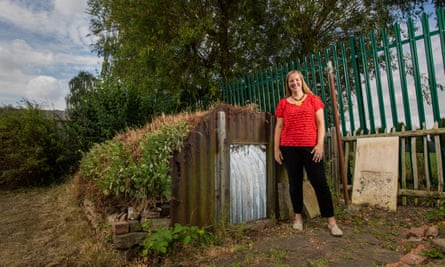
Her father was killed by a German bomb while he was on Home Guard duty at Charlton station. She was evacuated when the blitz started, but her mother brought her back home after a near-fatal bout of diphtheria. Back in London, the bombing raged on, and Longley recalls using the shelter a lot. “It was pitch black. No lights or candles or torches – they were all banned during the war. Sometimes we slept with our clothes on because of one raid after another. Sometimes we slept in the Anderson shelter all night because it wasn’t worth getting out.” There was nothing comfortable about Longley’s shelter, either: “Ours wasn’t a very posh one. Some people made them comfortable. But there were nine of us. It was cramped, cold, dark and there were lots of creepy crawlies.” Longley’s mum did her best to make things more bearable for her and her siblings: “She would get a tin of broken biscuits from Woolworths to eat. And she would take a few bottles of milk.”
David Hesketh, 82, was also an infant when the war began and says he was oblivious to much of the terror going on around him. He grew up in Walton in Liverpool, beneath the German flight path to the Albert docks. While two of his siblings were evacuated to Shrewsbury, he and his older sister, Muriel, remained in the city. “We had an Anderson shelter in our back garden. Muriel told me that when we slept out there together, I just slept like a log throughout the whole thing; throughout all the raids. She stayed awake all the time, scared stiff by the noise.” Muriel was also jealous of his Mickey Mouse gas mask, as hers was plain. After the war, Hesketh said that the shelter was kept for a short while and may have been used to store garden tools or even as a shelter for the hens his parents kept.
Margaret Elliott, 92, who lived in Canning Town, east London, says she saw the whole thing as an adventure at the time. She was 13 when the war started and her father installed their shelter quite early on – she recalls playing in it prior to the air raids. “I remember my father grew tomatoes on top of it. And we had one or two false alarms and we’d go down – it was very cold and damp. My father made little steps inside for us to get down and a little seat for us to sit on.” Elliott says she could have slept in her shelter, but her mum was so nervous that she wouldn’t allow it.
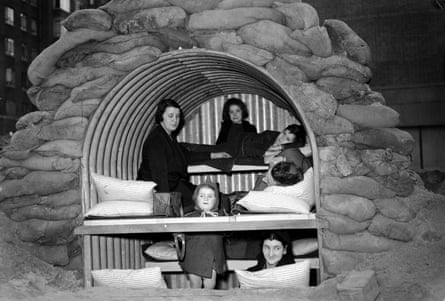
Elliott eventually moved out of the city as the bombing intensified. “One day, the raids were so bad that we were down in the shelter for most of the day. I remember by this time my mother was quite hysterical and my father decided to take us to her sisters in Hertfordshire. So, we got on the top deck of a bus and drove all the way up to London through where the docks were, where there were flames to either side of us.” Elliott wasn’t fazed by the bombing, as she still visited London to see friends: “I used to go to dances, we still went up there regardless of the doodlebugs (V-1 flying bomb) and all the rest of it,” Elliott says. “We just carried on. I still have that attitude now, I just carry on.”
The survival of Anderson shelters is not only due to their sturdy structure. Millions of families took refuge in them during the war and told their stories to succeeding generations, preserving them in our cultural imagination, too. “I think the Anderson shelter is an icon because so many people had them,” Johnson says. “They figure in many wartime novels and films. I think they do appeal to our den-building fascination.” The shelters are also one of the few relics of the period that can still be utilised. They are an effective and fun way of educating young children about the realities of the home front, and many people are still putting them to good use in their gardens. Johnson says she intends to keep her shelter for as long as she owns her house and has plans to develop the inside as a sleep-out space for her children.
“When we landscaped the garden, we even had a powerline put down to the end of the garden, right by the shelter.”
- Second world war
Comments (…)
Most viewed.
- New & Now
- Plan Your Visit
- Things To Do
- Where To Stay
- Restaurant Directory
View this post on Instagram A post shared by Kid Escapades (@kidescapades) on Feb 26, 2019 at 2:16am PST
On 15 June 1941, the news was out that thousands in Malta had no air raid shelter and too many civilians were being left at the mercy of fate as bombs showered down upon them. Five thousand men were deployed to construct 400 public rock shelters in addition to the 473 already in use. Even this endeavour, however, would leave tens of thousands unprotected, out of a population of 270,000.
Therefore, shelters were overcrowded and uncomfortable. However, they were the only guarantee of safety while Malta became the most bombed place on earth. Visit Malta and Gozo’s’ air raid shelters to get an insider’s perspective of living underground to save your life during World War II .
1. Mellieha Air Raid Shelter
One of Malta’s largest shelters, the Mellieha Air Raid Shelters consist of over 500 metres of hand-hewn corridors and private family rooms, as well as anti-blast chambers, a maternity clinic and a treasury.
View this post on Instagram A post shared by Malin Stenberg (@malinstenberg72) on Dec 2, 2017 at 12:20am PST
2. Wignacourt Museum Air Raid Shelter
The Wignacourt Museum World War II shelters in Rabat consist of about 50 rooms that could accommodate circa 350 people. Two main corridors were provided by the government; then each family paid to have a room dug out with pick axes. The numbered rooms were made homely by use of paint, tiles and makeshift doors made out of wooden planks!
View this post on Instagram A post shared by sara dolfi agostini (@saradolfiagostini) on Aug 27, 2017 at 5:16am PDT
3. Villa Bologna Air Raid Shelter
The tour around Villa Bologna and gardens includes a visit the family’s World War II shelters. The private shelters had an entrance through the cellar of the house and an exit onto the garden, and included marble steps and electricity. The shelter has a main room, previously an 18th century well, and four little rooms, probably sleeping quarters and a food storage space.
View this post on Instagram A post shared by Monica De Micheli (@saltaamalta) on Dec 4, 2018 at 2:45am PST
4. Il-Barri Mgarr Air Raid Shelter
This rock-hewn shelter lies beneath the il-Barri restaurant near the village church of Mgarr. Reaching a depth of 12 metres and spanning some 225 metres, it is one of the largest underground bomb shelters in Malta. It was dug entirely by hand and used by about 400 people. Only half of the shelter’s maze of corridors are open to the public yet the restricted spaces with low ceilings, rough ground, and damp atmosphere by candlelight provide a good insight to what life in the shelter might have been like.
View this post on Instagram A post shared by Tara Darmanin (@taradarmanin) on Apr 5, 2018 at 4:08am PDT
5. Casa Rocca Piccola Air Raid Shelter
A tour of Casa Rocca Piccola in Valletta also takes you to the bomb shelters below the house. Although the house belonged to a noble family, over 100 people sheltered here from the bombs that poured onto Valletta. The air raid shelters of Casa Rocca Piccola include around 100 stone steps and narrow tunnels with rough, uneven surfaces.
View this post on Instagram A post shared by Dan Farrow (@danfarrow9) on Jul 14, 2019 at 3:01am PDT
6. Malta at War Museum, Couvre Porte, Birgu
The Malta at War Museum showcases the ordeal of the people of Malta during the Blitz in World War II. It includes an underground bomb shelter below it, which at that time lay beneath a police station. Explore a real air raid shelter as well as period artefacts and war memorabilia to truly immerse yourself in the WWII experience.
View this post on Instagram A post shared by Michael Havard-Bilton (@michaelhbuk) on Mar 11, 2019 at 9:14am PDT
7. Cittadella Air Raid Shelter
The Cittadella Air Raid Shelters in Victoria, Gozo, have only recently opened to the public, in March 2019, thanks to an extensive restoration project by the Wirt Ghawdex foundation. Out of some 170 public shelters in Gozo created between 1941 and 1942, 20 were in Rabat. Since the town’s core stands on clay, two large shelters were dug near the main entrance to the Gozo Citadel.
View this post on Instagram A post shared by Nicole (@niccapap) on Jun 3, 2018 at 10:54am PDT
Have you been to any of these shelters? Now aren't you glad to be in a war-free zone?
23rd August 2019
- Get in touch
We use cookies to enhance your browsing experience, serve personalized ads or content, and analyze our traffic. By clicking "Accept", you consent to our use of cookies.
Sign Up and save all your favourite restaurants, attractions, events, articles and experiences for a later date and access them from any device.
Loading Search Results

Valencia's air-raid shelters
System messages
Valencia's air-raid shelters
One of the periods in recent history that people are most curious about is the Spanish Civil War. It was at the beginning of the conflict, in 1936, when the capital of the Second Republic was transferred to Valencia, making it a strategic target. Bombing attacks on the city increased, creating the need to build air-raid shelters to protect the civilian population from the bombs.
Valencia’s becoming the capital of Spain was also accompanied by an interesting cultural movement. Even in difficult times, creativity and design find a way.
How to visit some of Valencia's air-raid shelters
With the idea of protecting the population from the direct impact of the bombs and shock waves, during the Civil War, a number of shelters were built in Valencia, allowing people to seek protection until the attacks had passed. Both public and private buildings were used for the general public or set aside for a specific group of people. Around 50 were built in different sizes , using two construction solutions: a post-and-lintel system or vaulting. While some had bathrooms and even kitchens, others did not even have a toilet.
n addition to the network of shelters to protect the civilian population set up by the republican government, some 200 basements were also fitted out.
Today it is possible to visit some of them. We invite you to recall the past and put yourself in the place of those whose lives were saved by these facilities.
The design of the labels of the shelters
Fortunately, the original purpose of all the shelters no longer applies.
However, the typography of their signs has transcended the years. So much so that even the Atypical Valencia brand, created by Valencian designers, came up with a wooden magnet with original packaging reproducing the famous sign that looks out at us from a number of façades around the city.
Whether or not they are open to visitors, Valencia’s air-raid shelters form part of its history. They are an example of the tendency towards and talent for design that binds to Valencia's DNA and can be found in its streets and buildings.
It is thus no surprise that the city has been named World Design Capital 2022, and its activities include highlighting the different signs decorating it.
We encourage you to discover one of the shelters as you walk the city, seeking out unexpected spots filled with design in Valencia.
Visit the air raid shelters of Valencia
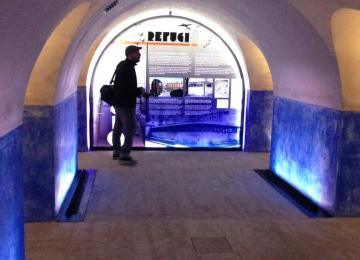
Council School air-raid shelter
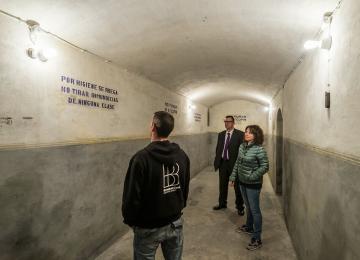
Bombas Gens shelter
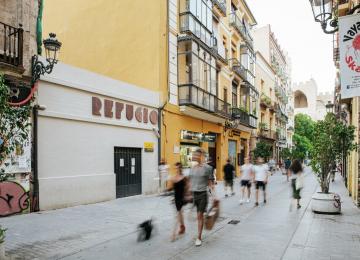

Serranos Street shelter
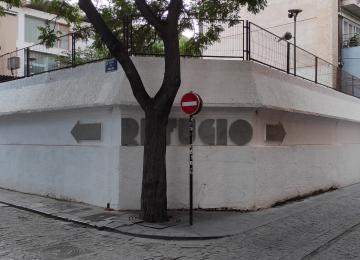
Alta Street air-shelter

Espada Street shelter at Tetuán Square
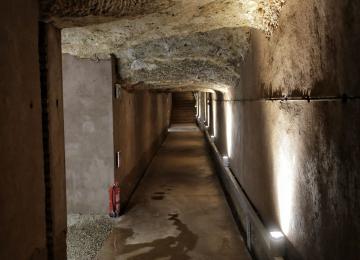
Massarrojos air-raid shelter
Subscribe to our newsletter.
Do not miss the best plans in Valencia!
© VISIT VALÈNCIA 2024 | FUNDACIÓ VISIT VALÈNCIA

A Look Inside Clapham South’s Deep Level Shelter

The London Transport Museum run Hidden London tours of various disused tube stations and subterranean sites. I went on their fascinating tour of the Clapham South Deep Level Shelter.

To start the tour you enter via this round structure on Balham Hill, before descending 180 steps below the surface.

Down in the depths, between the intermittent rumblings of the Northern Line above your head, the guide then takes you through the history of this incredible site.
An Air Raid Shelter
During the Blitz from 1940-41 Londoners naturally sought shelter wherever they could, including in underground stations.
The government were not that keen on this practice in general anyway and the public also started to protest for better provision of shelters. Incidents, such as the bomb that hit the booking hall at Bank station on 11th January 1941 killing 56 civilians, also sparked the authorities into action.
They therefore ordered the construction of a series of deep level shelters along the Northern line.

London Transport was judged to be the only organisation capable of the project. Thankfully lots of the design and surveying work had already been carried out for the tunnels for a new express train line, following the route of the Northern line.
8 deep level shelters were built in total, each able to hold 8000 people.
The shelter consists of two 400 metre long tunnels with an upper and a lower section. Each sub-section at Clapham South is named after an admiral or naval figure.

By the time the shelters were finished in 1942 the Blitz had ended, however five, including Clapham South, were opened from 1944-45 during the V1 and V2 rocket attacks.
Conditions In The Shelter
The government in their attempts at moral boosting referred to the shelters as ‘Underground palaces’, which feels a bit generous.

The shelters had rows of triple-tiered bunk beds. Those sheltering did however to bring their own bedding (imagine having to drag your mattress down all those stairs…).

Should you want to use the shelter you would have to get a ticket from your council and this ticket would then assign you to a section and a bed.
As well as sleeping quarters there was also a medical centre, washing facilities and a canteen. There was apparently uproar at the canteen when the price of tea was raised to 2d (a tuppence), double the price of tea at ground level! Good to see Londoners had their priorities right.

Music would often be played over the PA system to encourage dancing and a community atmosphere.
The ‘Penny Hotel’
Bizarrely, after the war, they upgraded the facilities at Clapham South slightly and it was used as a cheap hotel for visitors to London, known as the ‘penny hotel’. No chance of a room with a view here!

In 1948 some of the migrants that disembarked from the Empire Windrush were put up here until they could be found somewhere to stay. After four weeks all had been found accommodation elsewhere.

In 1951 it was rebranded as the ‘Festival Hotel’ for visitors to the Festival of Britain.
In 1956 soldiers billeted at the Goodge Street shelter accidentally started a fire. No-one was hurt but it took the authorities 3 days to put out and subsequently all the shelters were closed as accommodation.
The Shelter Today

Today 7 of the 8 shelters are owned by Transport for London and are used for various purposes, including as archives and storage. The Clapham Common Shelter is used as a hydroponic farm, growing fruits and vegetables!
The tour was really fascinating and highly recommended. You can find out more about dates and booking here .
Thanks for reading! More of London’s historical hidden gems below.

My Top Ten Historic Churches In London

A Visit To London’s New Roman Wall Museum

A Wonderful Day Trip To Historic Hastings

15 Amazing Overlooked Details To Spot At Westminster Abbey
Share this:, 3 thoughts on “a look inside clapham south’s deep level shelter”.
I slept in the Clapham shelter in 1951. I was 12 years old and one the 24 boys and 22 men of the Holy Trinity Church Choir from Huddersfield that won the Festival of Britain Church and Chapel class. Our picture was taken in the shelter at 1-00am by Reuter and appeared in a national newspaper
How rascinating thank you! Do you know if the photo still exists? Jack
Pingback: A Look Inside The Abandoned Aldwych Tube Station - Living London History
Leave a Reply Cancel reply
- Accessible Accommodation
- Bed & Breakfast
- Boating Holidays
- Cabins & Lodges
- Camping & Touring
- Dog Friendly
- Holiday Parks
- Pubs & Inns
- Self Catering
- Culture & Arts
- Getting Around
- Practical Information
- Itineraries
- Get Inspired
- Travel Trade
- Attractions
- Destinations
- What’s On
- Toggle Menu
- Toggle Search
- See & Do
King’s Lynn Air Raid Shelter

Two structures, which have lain hidden beneath the Tuesday Market Place in King’s Lynn, would have provided protection to people during the Second World War. Whilst they have been undisturbed for years, recent survey work in preparation for the refurbishment of the town’s historic square has drawn attention once again to the oft-forgotten air raid shelters, which are just feet below the surface of the Tuesday Market Place.
Believed to have been there since 1940-41, the two shelters are constructed from steel-reinforced concrete. Each shelter is around 8′ to 10′ deep and together would have accommodated around 350 to 400 people.
You may well find the air raid shelters open and accessible during the town’s very popular Heritage Open Day in September each year (see local press or Visit West Norfolk website nearer the time for more information), after the shelter was open to the public for the first time in decades during September 2014 (thousands of curious people entered the shelter during that day).
Closed From Christmas Eve to Boxing Day, and New Years Day. Monday to Sunday: 10am-4pm
Privacy Overview
This website uses cookies to improve your experience while you navigate through the website. Out of these cookies, the cookies that are categorized as necessary are stored on your browser as they are as essential for the working of basic functionalities of the website. We also use third-party cookies that help us analyze and understand how you use this website. These cookies will be stored in your browser only with your consent. You also have the option to opt-out of these cookies. But opting out of some of these cookies may have an effect on your browsing experience.
Necessary cookies are absolutely essential for the website to function properly. This category only includes cookies that ensures basic functionalities and security features of the website. These cookies do not store any personal information.
Any cookies that may not be particularly necessary for the website to function and is used specifically to collect user personal data via analytics, ads, other embedded contents are termed as non-necessary cookies. It is mandatory to procure user consent prior to running these cookies on your website.
World War 2 Air Raid Shelters: Facts and Information
Several different types of air raid shelters were used by the people of Britain during the Blitz of World War 2. Some of these shelters made use of structures and underground spaces which already existed, and some of the shelters were constructed from scratch.
Here are some details about some of the different types.
Cellars and Basement
- Cellars were used as very effective underground bomb shelters. Unfortunately, compared to other European countries, very few houses in Britain had cellers – they were only built in large houses and older properties.
- The basements of public buildings such as schools, hospitals, and the basements of businesses were used as shelters during the Blitz. The basements offered underground protection from bombs, but there was the risk of heavy machinery falling on top of the shelter if the site was hit.
Railway Arches and the Underground
- Railway arches, constructed of brick, offered good protection from falling bombs and they were certainly used as air raid shelters in the Blitz. The only problem was that railway lines were sometimes targeted by the Germans in bombing raids.
- The Government was against people sheltering in the Underground tunnels during air raids. They thought that disease would spread (due to the small number of toilets in some stations), people would fall on the tube lines and that people might be tempted to never leave the safety of the tunnels. All of these arguments were proved wrong and Londoners took matters into their own hands by forcing their way into the Underground stations.
- The Government changed its views on this type of shelter and started fitting out Underground stations with bunks, first aid kits and chemical toilets.
- Underground stations were not completely safe as bomb shelters – they were still vulnerable to a direct hit.
- It is estimated that over 170,000 people used the London Underground as an air raid shelter during the Blitz.
Other Tunnels and Caves
Throughout Britain during the Blitz, people were making use of any underground spaces as a means of sheltering from the German bombs. Naturally forming caves and tunnels under castles, palaces and other historical buildings were frequently used.
Street Communal Shelters
- The Government started a a programme of building street communal shelters in March 1940. These shelters were to be constructed by private builders (under the supervision of Government inspectors and surveyors).
- The shelters were built with thick brick walls and a reinforced concrete roof.
- They could house about 50 people.
- Many street communal shelters were built.
- Unfortunately, the shelters didn’t perform very well in air raids. The brick walls were often shaken down allowing the concrete roof to fall on those inside.
- Improved designs were introduced, but public confidence in the communal shelters had been lost.
- The trend moved towards individuals building shelters on their own property with materials supplied by the Government.
Anderson Shelters and Morrison Shelters
- Anderson shelters were designed to house six people.
- They used curved and straight panels of galvanised corrugated steel, and they performed really well in bomb tests.
- Over 3 million Anderson shelters were put up all over Britain. They were free to all families who earned less than £250 a year.
Click the link to find out more facts about Anderson Shelters .
- The Morrison shelter was essentially a reinforced metal dining room table that a family could sleep under during the nighttime air raids.
- It was not designed to offer protection against a direct hit, but it was very effective at sheltering people from bomb blasts and falling debris. One study of bomb damaged houses showed that more than 80% of those sheltering in correctly positioned and constructed Morrison shelters survived without major injury.
Click the link to find out more facts about Morrison Shelters .
If you want to find out more about World War 2 , please visit our WW2 links page.
Leave a Reply Cancel reply
Your email address will not be published. Required fields are marked *
This site uses Akismet to reduce spam. Learn how your comment data is processed .
Amazon Affiliate Disclaimer
- ALL MOSCOW TOURS
- Getting Russian Visa
- Top 10 Reasons To Go
- Things To Do In Moscow
- Sheremetyevo Airport
- Domodedovo Airport
- Vnukovo Airport
- Airports Transfer
- Layover in Moscow
- Best Moscow Hotels
- Best Moscow Hostels
- Art in Moscow
- Moscow Theatres
- Moscow Parks
- Free Attractions
- Walking Routes
- Sports in Moscow
- Shopping in Moscow
- The Moscow Metro
- Moscow Public Transport
- Taxi in Moscow
- Driving in Moscow
- Moscow Maps & Traffic
- Facts about Moscow – City Factsheet
- Expat Communities
- Groceries in Moscow
- Healthcare in Moscow
- Blogs about Moscow
- Flat Rentals
The Moscow Metro – MCC – MCD – everything about capital’s subway
Moscow Metro map and journey planner app called Yandex.Metro is available for iOS and Android for free.
We have a great Moscow Metro & Stalin Skyscrapers Private Tour across all famous metro stations, available for you every day.
1. Famous Moscow metro stations
Kievskaya (circle line).

The station was opened on March 14, 1954. It was named after the nearby Kievsky Railway Station. Decorating of station is devoted to friendship of Russian and Ukrainian people. Rich mosaic decoration is made from smalt and valuable stones by project of Ukrainian architects, chosen from seventy-three works presented on competition.
Kievskaya (Dark-blue line)
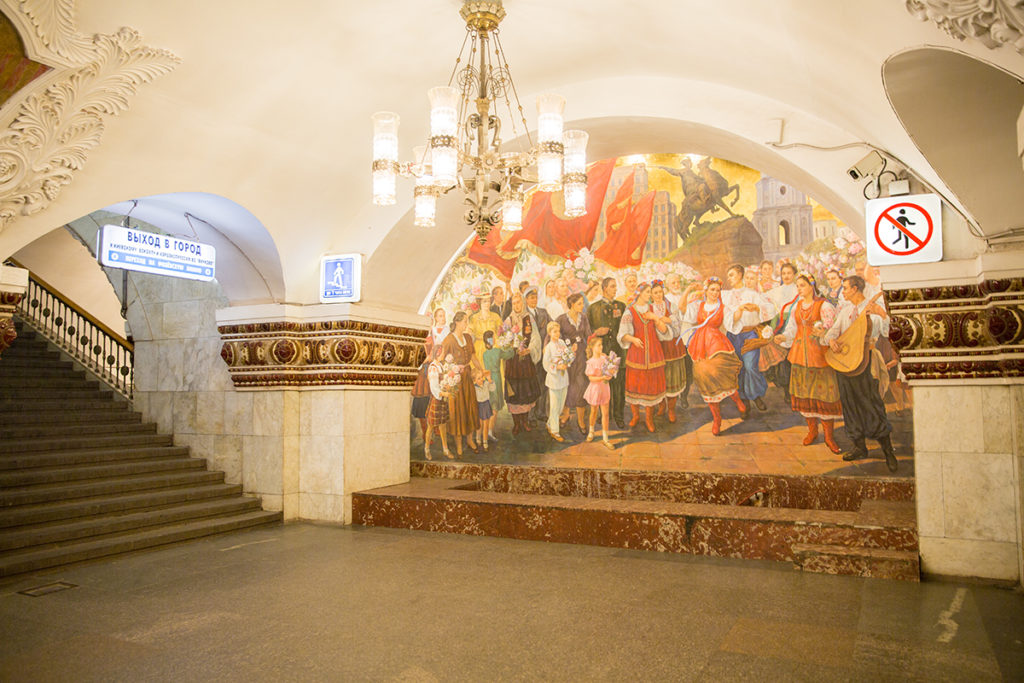
It was opened on April 5, 1953. Design of the station is devoted to the Soviet Ukraine and reunion of Ukraine and Russia. The station is decorated with a large number of the picturesque cloths executed in style of socialist realism in fresco technique. The fresco «Holiday in Kiev», made in 1953 was practically destroyed in 2010, due to an accident during nearby constructing works. While the fresco recovery, restorers revived its original appearance that had gone through many changes since its creation.
Ploshad Revolutsii

The station was opened on March 13, 1938. The most interesting feature of the station is 76 bronze figures, situated in niches of 18 arches. This peculiar gallery of images of Soviet people, aimed to personify force and power of the country, its glorious past and bright future. One of the bronze sculptures — a dog that accompanies a frontier guard — is believed to bring good luck if you touch its nose.
Prospekt Mira

Prospect Mira station of the Circle line was opened on January 30, 1952. It used to be called Botanical Garden up to June 20, 1966. The station’s decoration is devoted to development of agriculture in the USSR. Light marble and bas-reliefs by sculptor G. I. Motovilov decorate poles of the station. Famous smalt panel «Mothers of the World» by A. N. Kuznetsov is situated in the lobby.
Komsomolskaya

Komsomolskaya station was opened on January 30, 1952. The station has rich decoration devoted to a fight of USSR against overseas aggressors and victory in the Great Patriotic War. Mosaic panels from smalt and valuable stones, created according to sketches of the Lenin Award winner Pavel Corin, represent famous Russian commanders and weapons of different eras.
Novokuznetskaya

The station was opened on November 20, 1943. Its name was originally written through a hyphen: ‘Novo-Kuznetskaya’. The interior of the station is rich with decorating elements. The idea of creative force and power of Soviet people, its remarkable victories in the Great Patriotic War found realization in architectural design of station. The perimeter of the escalator arch is decorated with bronze sculptures by the sculptor N.V.Tomsky.
Novoslobodskaya

Novoslobodskaya station was opened on January 30, 1952. It was called after Novoslobodskaya street, where the station is situated. 32 original stained-glass windows from multi-colored glass, framed with steel and gilded brass and the famous mosaic panel «World peace», situated at the face wall the station, are made by sketches of Pavel Dmitriyevich Corin.
Dostoyevskaya

Dostoevskaya is comparatively new station, opened on June 19, 2010. It is situated at Suvorovskaya Square. Russian writer Fedor Dostoyevsky was born and lived in this district of Moscow. Therefore, the station bears his name and features scenes from his works «Crime and Punishment», «The Idiot», «Demons», «The Brothers Karamazov». Artist Ivan Nikolaev, the author of the decoration, said that depicting scenes of violence shows depth and tragedy of Dostoevsky’s work.
2. General information about Moscow metro
Metro working hours, navigation, wi-fi.
The Moscow Metro is open from about 5:30 am until 1:00 am. The precise opening time varies at different stations according to the arrival of the first train, but all stations simultaneously close their entrances and transitions to other lines at 01:00 am for maintenance. The minimum interval between trains is 90 seconds during the morning and evening rush hours. Each line is identified according to an alphanumeric index (usually consisting of a number), a name and a color. Voice announcements in Russian refer to the lines by name and by numbers in English. A male voice announces the next station when traveling towards the center of the city or the clockwise direction on the circle line, and a female voice – when going away from the center or the counter-clockwise direction at the circle. The lines are also assigned specific colors for maps and signs.
Free Wi-Fi is called MT_FREE and available on all 14 lines (inside the trains).
Using Metro services is frequently the fastest and the most efficient way to get from one part of the city to another. But during daytime Moscow Metro stations are usually overcrowded so if you want to just enjoy the beauty of the underground, it’s better to visit it late in the evening.
MCC and MCD
Since 2016 The Moscow Metro is connected to two new types of rail transport. The first one is MCC – Moscow Central Circle. It has 31 stations around the city with changes to metro stations (most of them require to walk a few minutes via the street). The second one is MCD, Moscow Central Diameters, a system of city train services on existing commuter rail lines in Moscow and Moscow Oblast. MCD has several lines, they’re being marked as D1, D2 etc. Changing to both MCC and MCD from the Metro is free when your journey is within the city. Both MCC and MCD lines exist on all of the Moscow Metro maps.
Interesting facts about Moscow metro
213 people were born in the metro during the World War II, when it was used as a bomb shelter.
There are 76 bronze sculptures of workers, peasants, soldiers, sailors, etc. at Ploshchad Revolyutsii station. There is legend connected with this station. To pass any examination successfully, a student should touch the bronze dog’s nose («the Frontier Guard with a Dog» sculpture). You can easily understand high popularity of this legend by looking at the polished nose of the dog.
It is said that some of the magnificent mosaics at several central stations, for example the «World Peace» mosaic at Novoslobodskaya, were made with the pieces of enamel and smalt, taken from the famous Christ the Savior Cathedral, before it’s destruction.
As any other dungeon the Moscow metro, has its own ghosts. The most famous one is the old lineman. He is not dangerous and usually hides into the wall, when people appear. The ghostly metro train is much more dangerous. It appears after midnight at the Circle Line and consists of old-time carriages. It sometimes stops at the stations and opens its doors, and then goes back into the darkness. It is said that the souls of Stalin’s prisoners, perished during the building of the metro are locked in the train forever.
3. Moscow Metro tickets
1 or 2 trips.
You can buy tickets in ticket offices or in automatic ticket machines. Passes for 1 or 2 trips are the most expensive. They sold only in ATM and cost 55 and 110 rubles (€0.55 and €1.10) respectively.
More than 2 trips
All the other kinds of tickets are available in the ticket offices. Tickets for bigger amount of trips are more profitable.
«90 Minutes» ticket
A ticket «90 minutes» is valid for one trip on the metro and an unlimited number of trips on surface transport within this time. It costs 65 rub (€0.65).
The «Troyka» card
You can also use «Troyka» – refillable card to pay for travelling on all kinds of public transport – metro, buses, trolley-buses, trams, monorail and blue minibuses. With «Troyka» one trip costs 35 rub (€0.35).

PLAN YOUR TRIP WITH US

Happy to help you with everything, from general plan of your visit to plane tickets or hotel stay. We may also support your Russian Visa request with a letter of invitation if you need so.
SEE OUR TOURS

We host around 60 tours every month in English, Russian, German, Italian, Spanish, Arabic and other languages. All of our tours =>
SAVE THIS LINK

If you only started to think about visiting Moscow, just save our site in your browser’s bookmarks or follow us on Facebook and Instagram to be in touch.
Tour Guide Jobs →
Every year we host more and more private tours in English, Russian and other languages for travelers from all over the world. They need best service, amazing stories and deep history knowledge. If you want to become our guide, please write us.
Contact Info
+7 495 166-72-69
119019 Moscow, Russia, Filippovskiy per. 7, 1
Mon - Sun 10.00 - 18.00
- Bahasa Indonesia
- Slovenščina
- Science & Tech
- Russian Kitchen
What went down in the Moscow Metro during WWII? (PHOTOS)
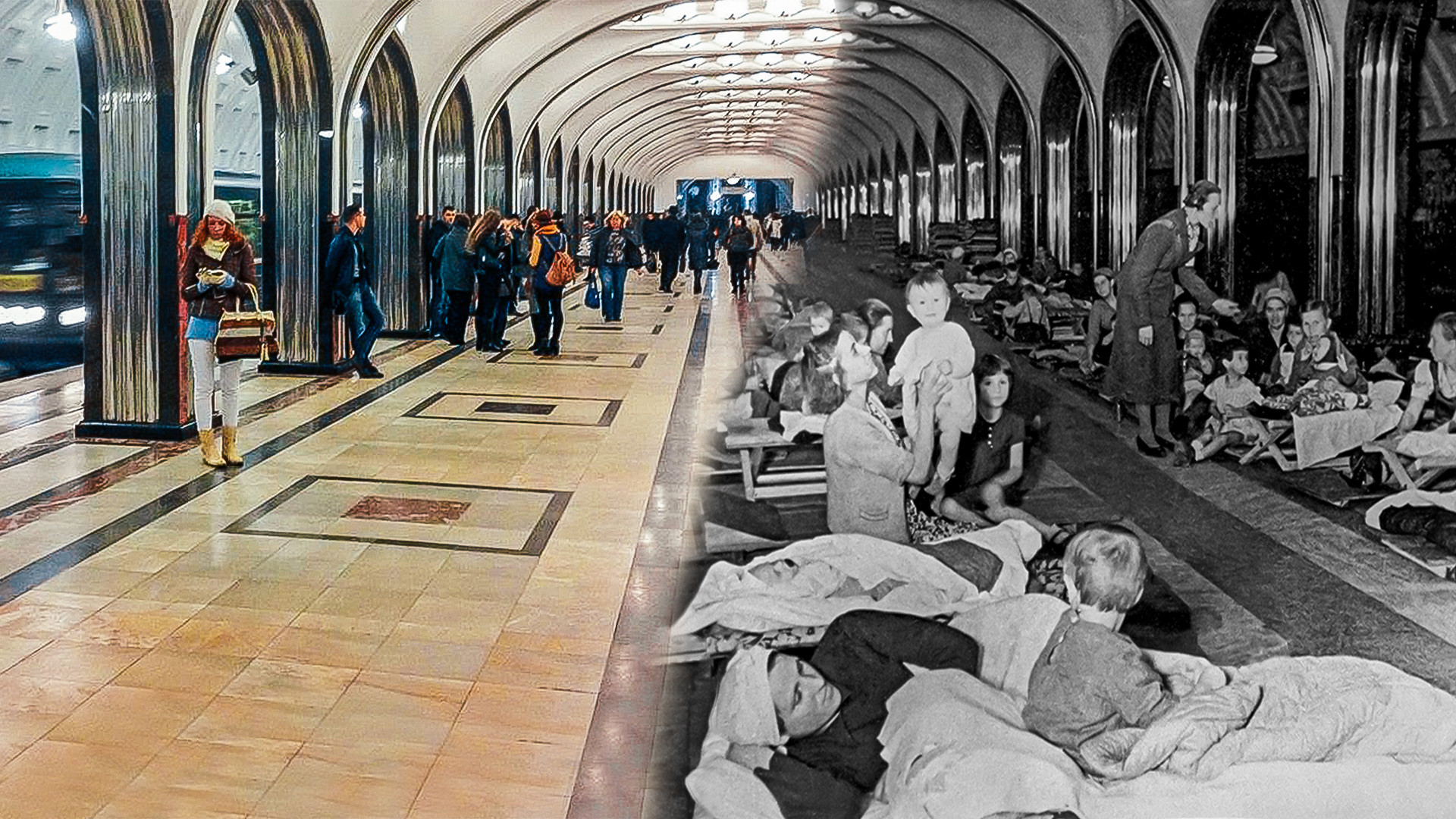
By the time World War II reached the Soviet Union in 1941, Moscow had built three metro lines with a total of 21 stations. During the war, the metro transported passengers by day and then turned into a bomb shelter at night. During bombing raids in 1941, it provided shelter to a total of 13.9 million people. In 1942, when air raids were less frequent, that number dropped to 303,000 people. The last shell fell on Moscow in June 1943, but the metro retained its status as a bomb shelter until the very end of the war.
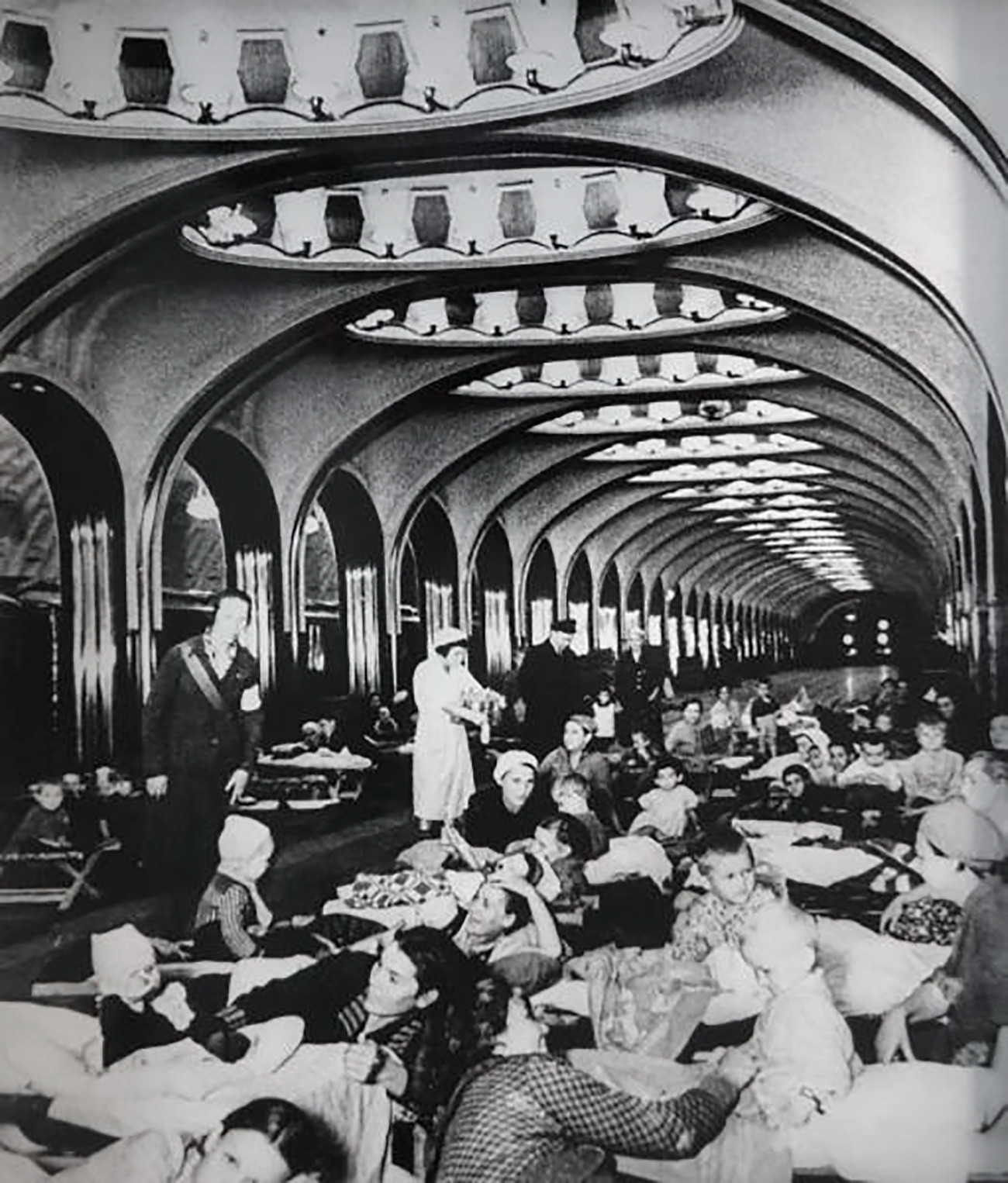
Mayakovskaya, 1941.
The first air-raid signal sounded in Moscow a month after the start of the war on July 22, 1941. Some 500,000 people hid in its stations and tunnels at the time. Another air raid took place the following night. One of the shells damaged the tunnel between Smolenskaya and Arbatskaya stations, another hit the overpass of a metro bridge and a third exploded at the entrance to the Arbatskaya station. Dozens of people were killed, including in stampedes at the entrance to the stations. After this, rules for using the metro as a bomb shelter were developed.
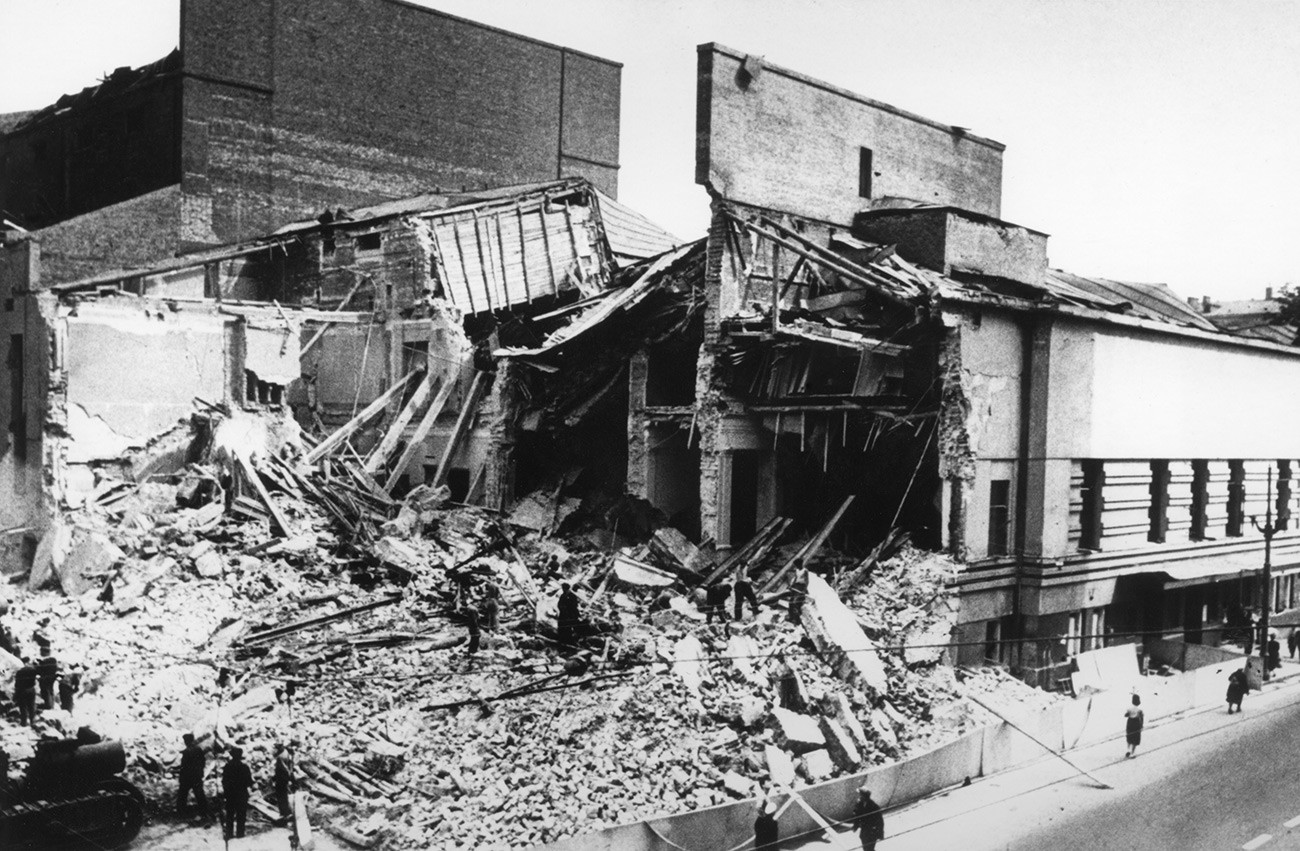
The theater on Arbat street, destroyed on July 1941.
During the war, the metro worked until 10:00 p.m. and then functioned as a shelter until 5:00 a.m. In the event of an air raid, trains stopped running immediately and metro personnel prepared to receive people. Moscow suffered its worst bombing in October and November 1941. During this period, trains stopped running between 5:00 and 7:00 p.m. and then Muscovites settled in for the night in metro coaches, at the stations and in tunnels.
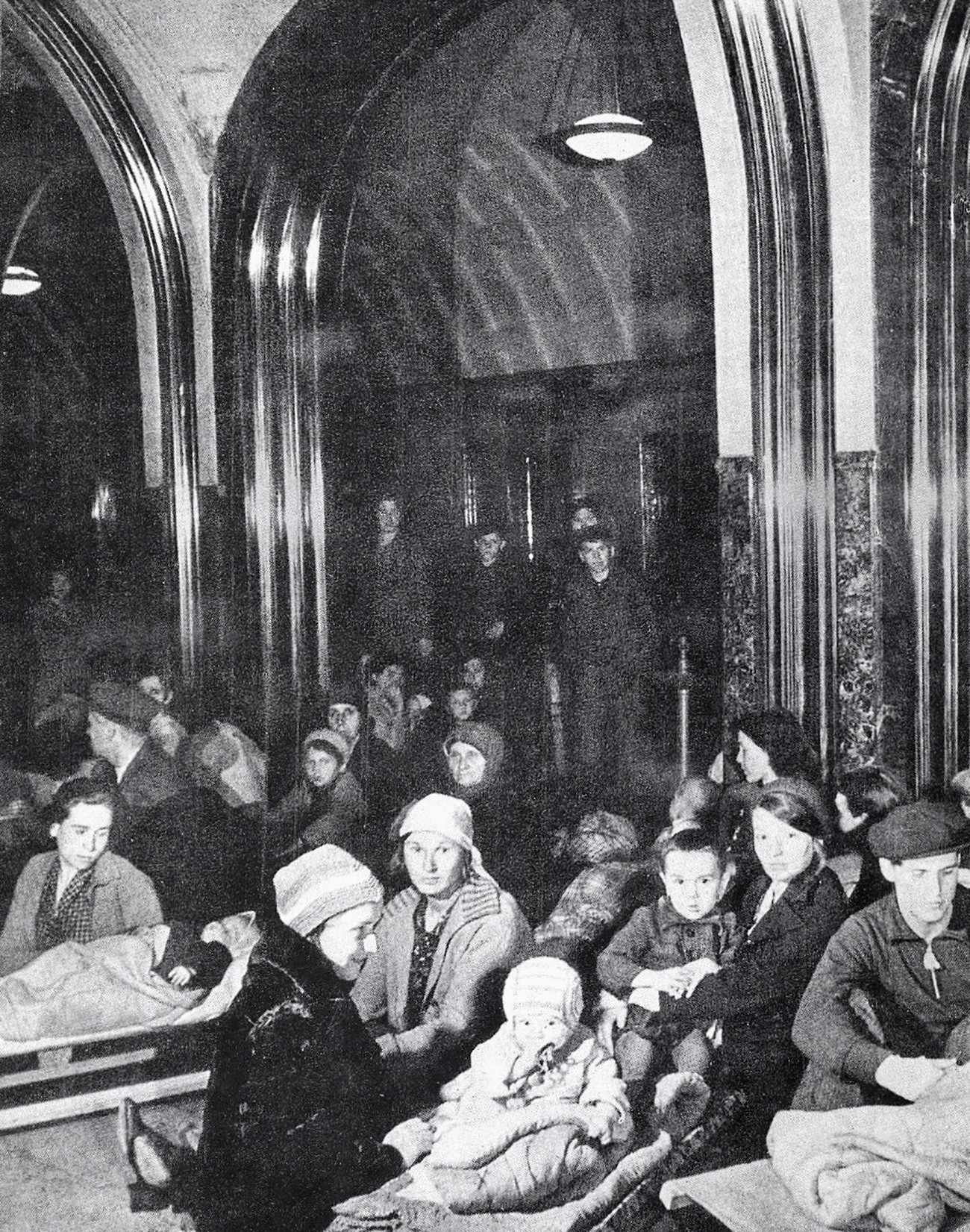
Mayakovskaya station.
According to the archives of the Moscow Metro, a total of 3,800 cribs and 4,600 beds for adults were installed at the stations. Drinking fountains and water taps were installed on the platforms, along with 25 toilets. Doctors were on duty at the stations at all time. In the evenings, children were given milk and white bread. In addition, some stations even organized movie screenings.

Milk for children, Mayakovskaya station.
In November 1941, a branch of the History Library was set up at Kurskaya station. “I visit it almost daily,” one of its patrons wrote . “Not because my journey home runs through this station, but because I come to read newspapers and other literature...The only drawback that cannot be eliminated is the circulating air from the movement of trains and a continuous stream of passengers.”

A library at the Kurskaya station.
The Chistye Prudy station (then called Kirovskaya) was closed to passengers and converted into a space for the General Staff. At the beginning of the war, the operational command, headed by Joseph Stalin, was based in a house near the entrance to the station, from which one could take an elevator to the underground complex of the command post and cross over into the station.
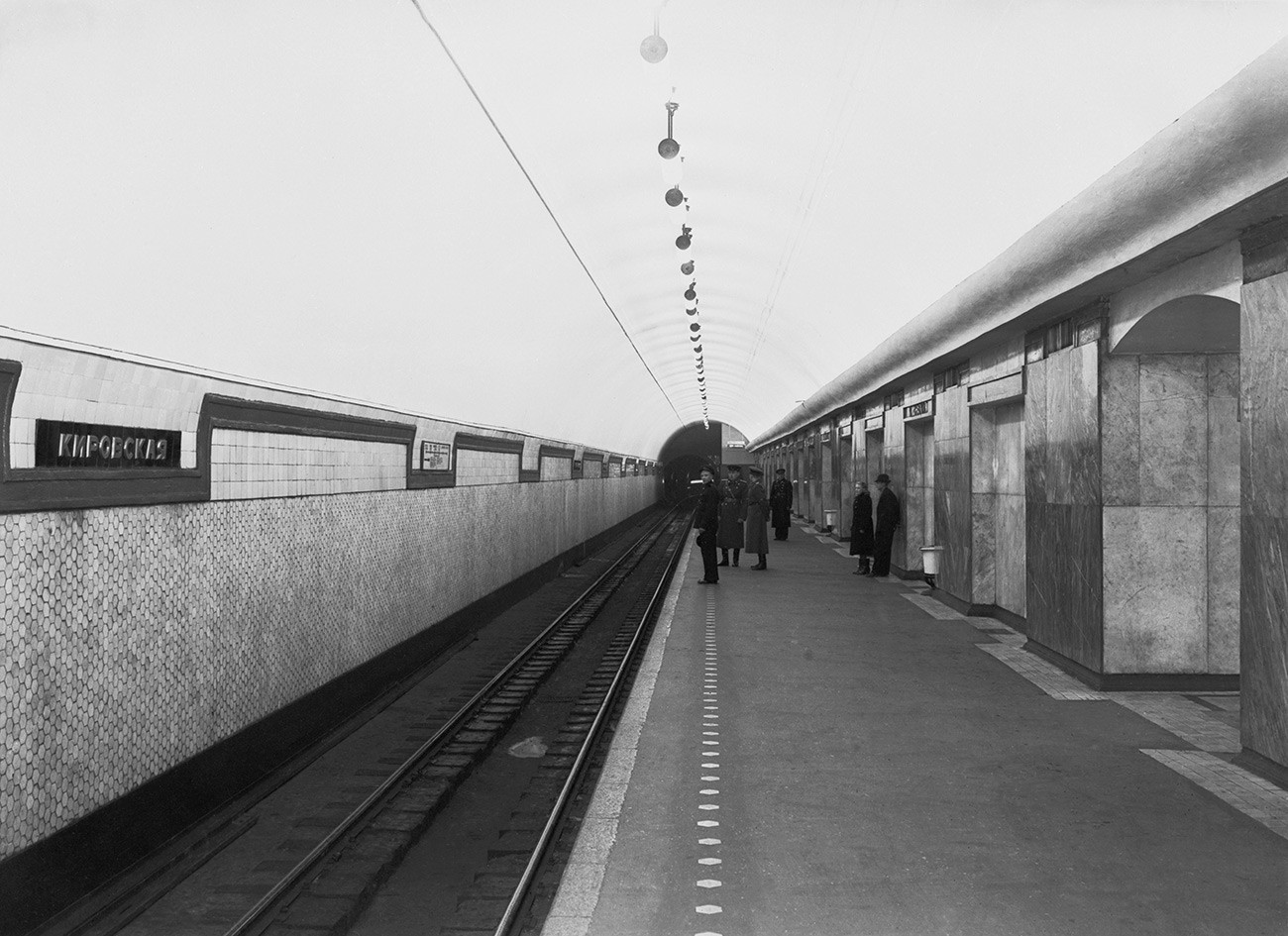
Kirovskaya (Chistye Prudy).
A plywood partition shielded the platform from passing trains, and a reinforced concrete wall was placed in front of the escalators to extinguish a blast wave in the event of a direct hit by an air bomb. The other military command posts were located at Krasnye Vorota, Belorusskaya and Ploshchad Sverdlova (now Teatralnaya) stations.
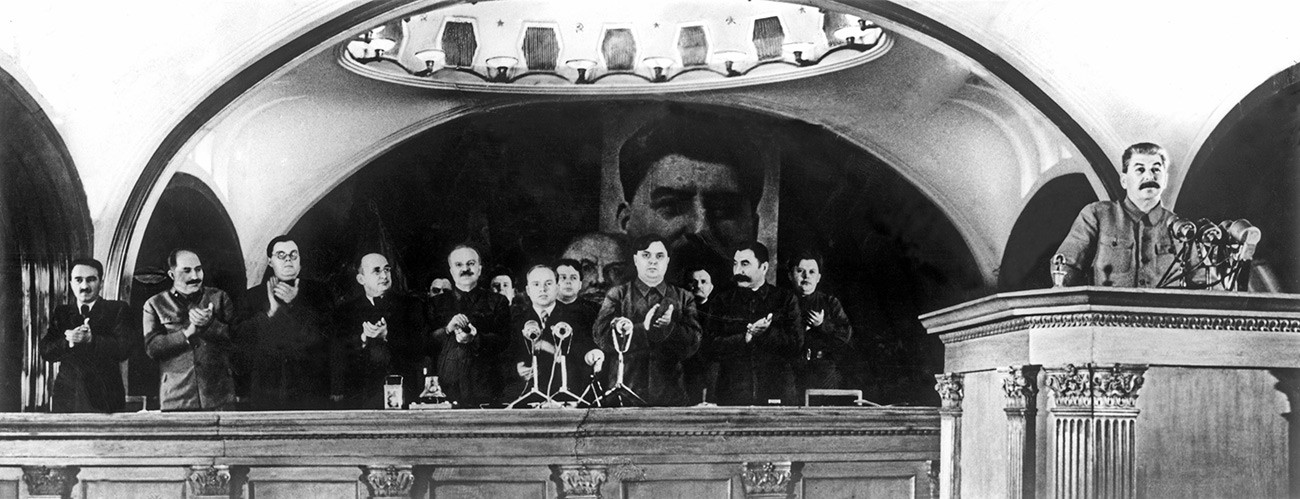
Preparations for the November 7, 1941 celebrations. Joseph Stalin making speech on 24th anniversary of Great October Socialist Revolution at the official sitting of the Moscow City Council. Mayakovskaya, November 6, 1941.
Despite the bombing, the Moscow Metro continued transporting millions of people. The only day in its history when the metro failed to open on time was October 16, 1941. The previous day, the Soviet leadership had decided to destroy the metro and evacuate its trains and other equipment to the rear so as not to surrender it to the enemy. On the night of October 15-16, preparations were under way to flood the station, electric cables were being cut and escalators dismantled. But then in the morning the decision was canceled, and at 6:45 p.m. the metro went back to work. However, some of the equipment was still evacuated to Uzbekistan, leaving only 105 metro coaches in Moscow. If before the war the metro carried 27 million passengers a month, in October 1941 that figure was just 8 million. (Nowadays, the Moscow Metro carries this many passengers in less than a day!)
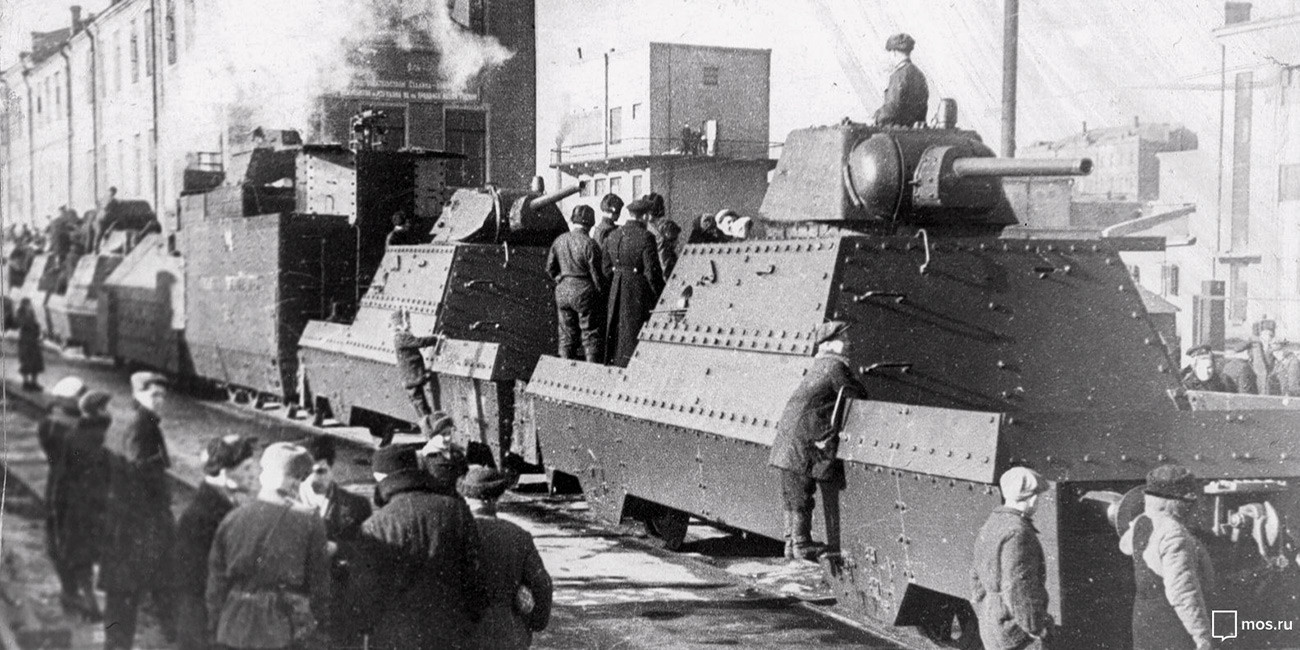
Moscow Metro armored train, 1943. Moscow's archive fund.
During the war, when the majority of men had been conscripted, the metro was staffed mostly by women. The first all-women train, which was run only by female drivers, appeared on March 8, 1942. Women continued to work in the metro after the war too. Some depots—for example, the one at the Sokol station—were used to make bodies for shells and mines.
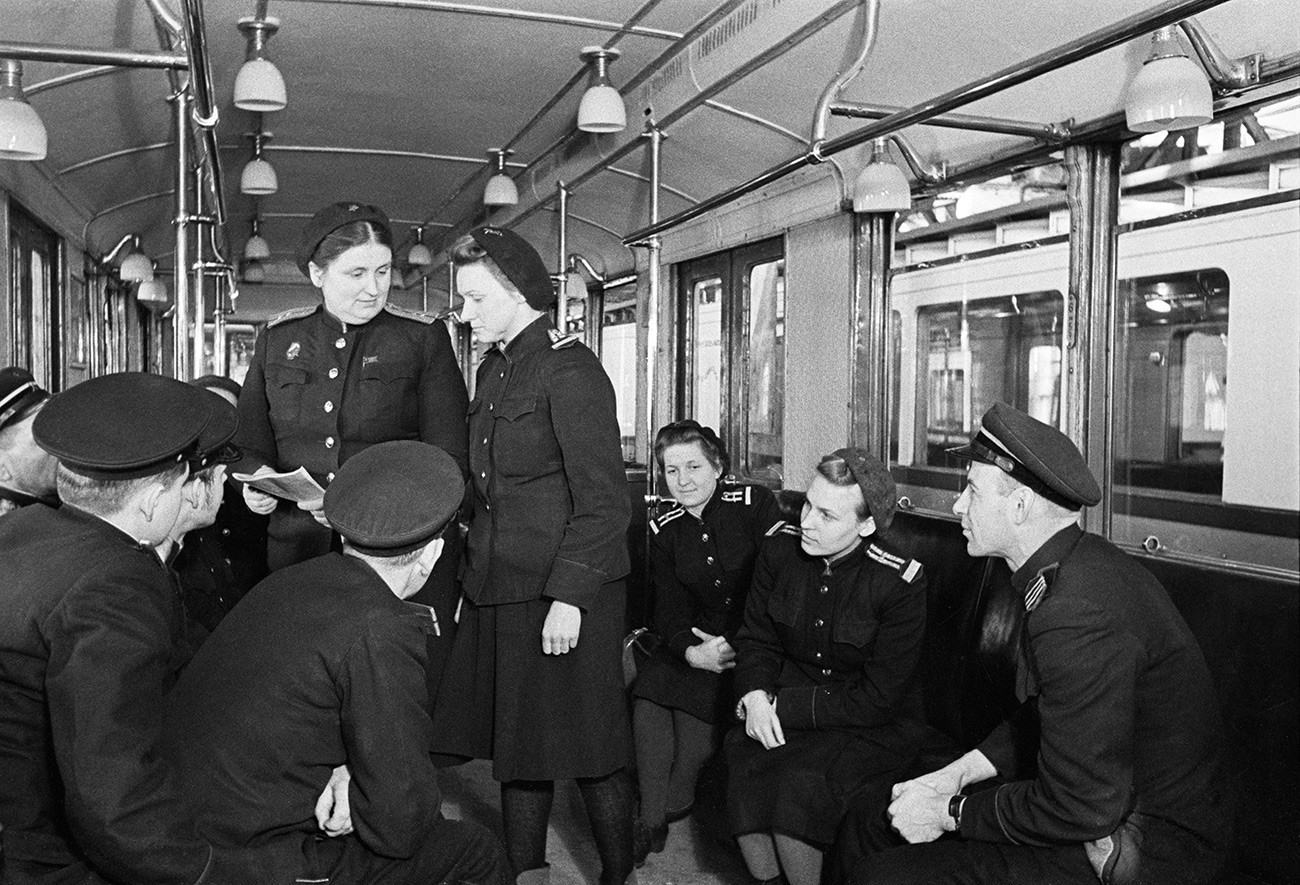
E. Mishina, standing, left, senior operator at the Severnoye maintenance facility of the Moscow Metro. 1949.
The city continued to build new stations and tracks despite the war. In 1943, a tunnel was laid under the Moskva River from Teatralnaya to Avtozavodskaya, and then from Kurskaya to Izmailovsky Park in 1944. Seven Moscow Metro stations have commemorative plaques reading: “Built in the days of World War II.”
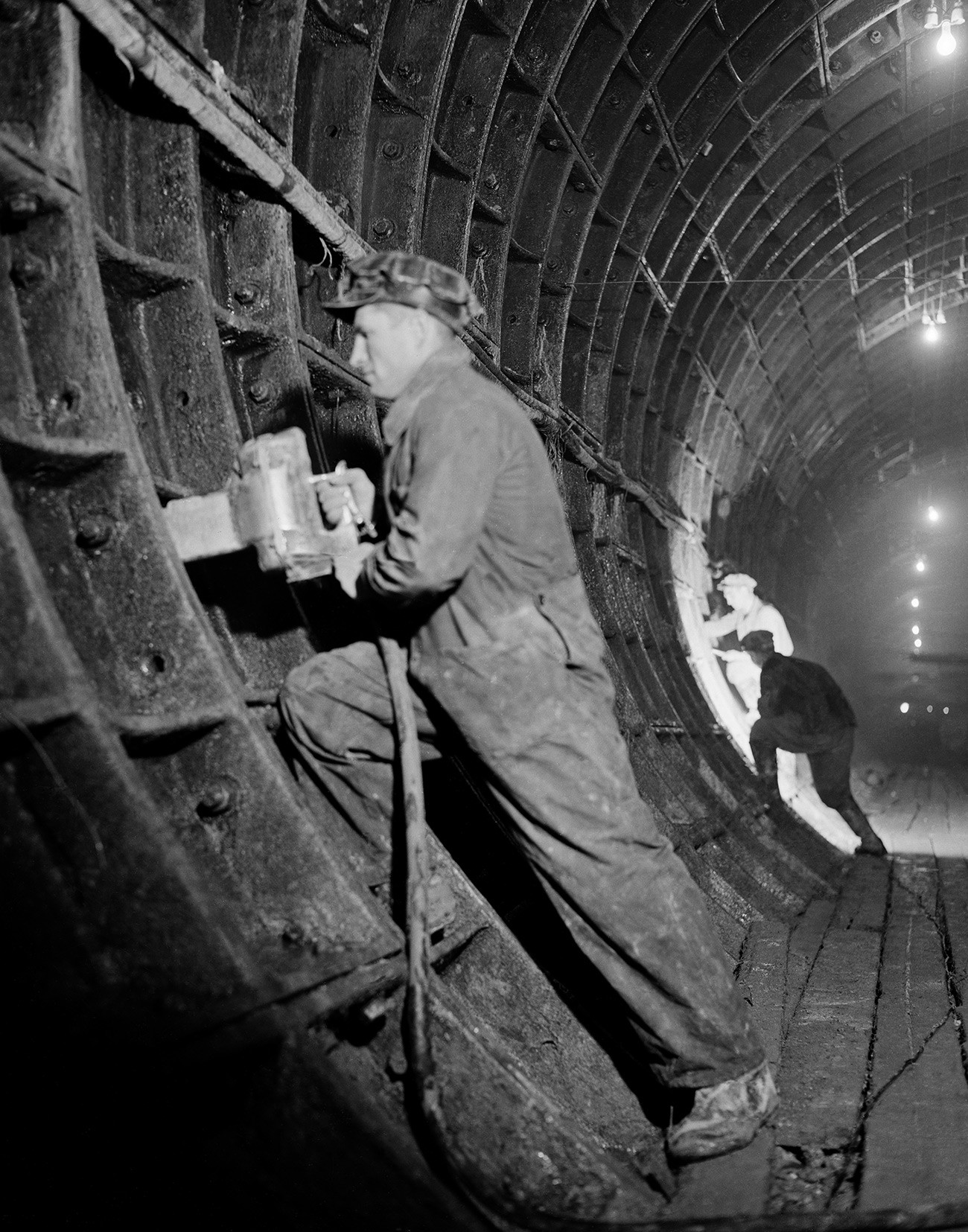
Building the Arbatsko-Pokrovskaya metro line in Moscow, 1944.
If using any of Russia Beyond's content, partly or in full, always provide an active hyperlink to the original material.
to our newsletter!
Get the week's best stories straight to your inbox
- 13 photos showing the heart and soul of Moscow metro daily routine
- Why this Ethiopian navy officer ended up as a metro driver
- Why is the Moscow Metro so fast and efficient?
This website uses cookies. Click here to find out more.

JavaScript off To get the best experience on this website please use a browser with JavaScript enabled.
Outdated browser You are currently using an old browser. To get the best experience on this website please update your browser
Last updated 23 February 2024
1. Self-guided tours
- Mondays: Closed
- Weekdays: 1pm to 4pm
- Saturdays: 10am to 4pm
- Sundays: 11am to 4pm
Prices as of April 2022.
Explorer tours: Going underground
Air Raid Shelters
- About the Air Raid Shelters
- Planning your visit
- School trips to our museums
- Support our museums
Israeli strike kills 7 aid workers in Gaza, World Central Kitchen halts operations
Israeli Prime Minister Benjamin Netanyahu said Tuesday his country’s forces had “unintentionally hit innocent people” in the Gaza Strip in the past day, after an airstrike killed seven aid workers with the disaster relief charity World Central Kitchen .
The U.S.-based nonprofit group, founded by celebrity chef José Andrés, said it was immediately pausing its operations in the region and Cyprus said that ships carrying aid were turning back after the incident — a major setback for efforts to get food into Gaza by sea for a population that has been pushed to the brink of starvation by the Israel-Hamas war.
Andrés said he was “heartbroken and grieving” for his colleagues who were killed.
“The Israeli government needs to stop this indiscriminate killing,” he wrote on X . “It needs to stop restricting humanitarian aid, stop killing civilians and aid workers, and stop using food as a weapon.”
Earlier, the Israel Defense Forces did not confirm that it was responsible for the deaths, and said that it would be opening a probe into the incident. “This will help us reduce the risk of such an event from occurring again,” IDF spokesperson Rear Adm. Daniel Hagari said in a video statement.
Speaking hours later as he departed a hospital, where he had undergone a hernia operation, Netanyahu said: “Unfortunately, in the last day, there was a tragic case of our forces unintentionally hitting innocent people in the Gaza Strip.”
“It happens in war, we check it to the end, we are in contact with the governments, and we will do everything so that this thing does not happen again,” he added.
Netanyahu's comments came as Israel faced a wave of indignation from humanitarian organizations and foreign leaders about the deadly strike.
Follow live updates here.
The charity said that its team had coordinated its movements with the Israeli military and that it was traveling in a “deconflicted zone” in two armored cars branded with the World Central Kitchen logo and a soft-skin vehicle.
Photographs from the site of the strike provided by international news agencies showed one of the three cars that staff were moving in completely burned out by the roadside. Another car had a large hole in its roof, directly through a World Central Kitchen logo.
World Central Kitchen said its convoy was hit as it was leaving a warehouse in the Deir al-Balah area of central Gaza, where the team had unloaded more than 100 tons of humanitarian food aid that the charity had brought to Gaza by sea earlier in the day.
The first such ship reached the enclave last month , as part of a new U.S.-backed effort to increase the flow of aid to northern Gaza, where aid agencies say Israel’s bombardment and blocking of relief efforts by land have left hundreds of thousands of people facing a possible famine.
Those killed were six international aid workers — a dual citizen of the U.S. and Canada, and team members from Britain, Australia and Poland — and a Palestinian driver. The charity did not release their identities.
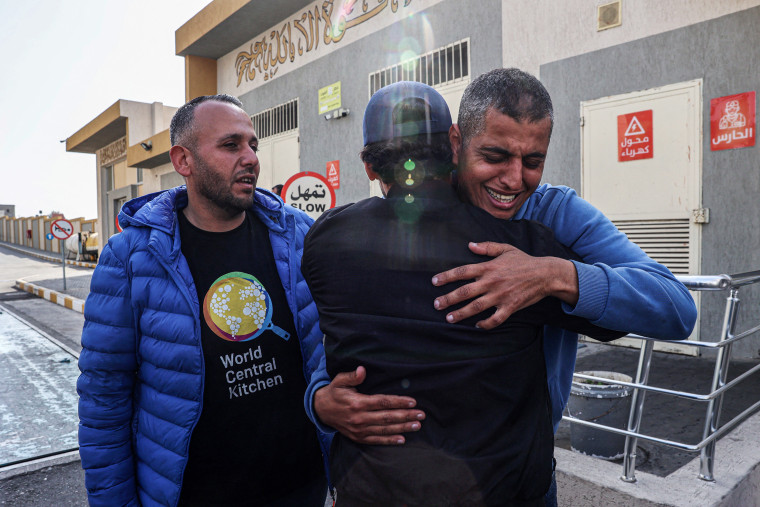
The U.S. led calls for a swift probe into the incident.
“We are heartbroken and deeply troubled by the strike,” National Security Council spokesperson Adrienne Watson said on X . “Humanitarian aid workers must be protected as they deliver aid that is desperately needed, and we urge Israel to swiftly investigate what happened,” she added. U.S. officials have been in touch with Israeli officials directly about the strike, a U.S. official told NBC News.
Australia condemned the strike and demanded accountability for the death of its citizen, whom it named as Lalzawmi “Zomi” Frankcom. Her family paid tribute to “our brave and beloved Zomi” who, it said, had been killed “doing the work she loves.”
Canadian Foreign Minister Melanie Joly said Tuesday that she was “horrified” to hear about the strike that took the lives of seven World Central Kitchen employees, including the Canadian citizen.
“We condemn these strikes & call for a full investigation,” Joly said on social media, adding that Canada expects full accountability for the killings and that strikes on humanitarian personnel were “absolutely unacceptable.”
Poland also decried what it said was a “disregard for international humanitarian law,” and Britain said the news was “deeply distressing” as it called on Israel to “provide a full, transparent explanation of what happened.”
World Central Kitchen CEO Erin Gore said the strike was “unforgivable,” describing it as an “attack on humanitarian organizations showing up in the most dire of situations where food is being used as a weapon of war.”
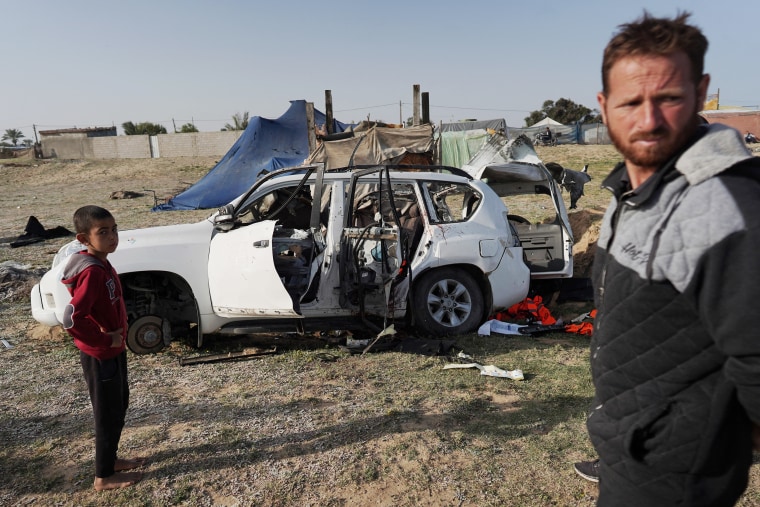
The charity said last week that it had served 42 million meals in 175 days of its operations in Gaza. Its suspension of those deliveries in the wake of Monday’s incident will add new uncertainty to international efforts to increase the flow of aid to northern Gaza, where hundreds of thousands of civilians are largely cut off from the outside world.
Cypriot Foreign Ministry spokesman Theodoros Gotsis told NBC News on Tuesday that about two-thirds of the undelivered aid shipment brought by World Central Kitchen to Gaza by sea this weekend is now returning to Cyprus in the aftermath of the incident.
The United Arab Emirates and Cyprus in a joint statement on Tuesday “expressed their profound condemnation over Israel’s strike on humanitarian aid workers of the World Central Kitchen (WCK).”
The nations said they “conveyed their deepest condolences and sympathies to the families of the victims and their countries, and to the management and staff of WCK, as well as their wishes for a speedy recovery for the injured.”
It is “imperative that Israel must exercise its responsibility to protect humanitarian workers who should be able to carry out this vital work safely and without fear of losing their lives,” they said in the statement.
Dr. Margaret Harris, a spokesperson for the World Health Organization, said in a statement that the charity’s mission was “de-conflicted,” meaning “both sides know they are coming, both sides have agreed.”
“The car was well marked, it was very clear it was World Central Kitchen. Now this is happening,” Harris said.
“We already have too few organizations with real capacity on the ground,” said Jan Egeland, secretary-general of the Norwegian Refugee Council charity. “This is another blow to a lifeline to 2 million defenseless and starving civilians,” he said in a phone interview.
The humanitarian group is not currently planning to suspend its operations but would have to be “even more cautious” for the safety of the 60 staff members on the ground in Gaza, he said.
Egeland said that he hoped this would prove “a watershed moment” in the push for a new cease-fire deal. “It’s the only sensible thing,” he added.
Monday's deadly strike is part of a troubling trend that has seen a record number of humanitarian workers killed since the Israel-Hamas war began, said Jamie McGoldrick, the United Nations aid coordinator for the Occupied Palestinian Territory.
“This is not an isolated incident,” he said in a statement. “As of March 20, at least 196 humanitarians had been killed in the Occupied Palestinian Territory since Oct. 2023. This is nearly three times the death toll recorded in any single conflict in a year.”
In February, more than 100 people were killed and hundreds more injured as thousands of Palestinians gathered in Gaza City to receive a much-anticipated aid shipment. The Israeli military said the majority of the victims were trampled or run over in a chaotic surge, but witnesses said the civilians were killed by Israeli gunfire and tank artillery shells.
More than 32,900 people have been killed in Gaza since the war began, according to local health officials, with many more feared buried under the rubble and presumed dead.
Since launching its operation in Gaza after the Oct. 7 Hamas-led terror attack, which killed more than 1,200 people, Israel has maintained a blockade and tightly controlled land crossings into the enclave, where the population of more than 2 million faces dire shortages of water and food, and is now on the brink of what the United Nations has said is an imminent famine.
Washington, Israel’s closest ally, has been pushing Netanyahu’s government to increase the flow of aid to Gaza, and has been airdropping humanitarian aid since last month.
President Joe Biden announced in his State of the Union address that he had directed an emergency mission to build a temporary pier off the coast of Gaza to enable ships to deliver humanitarian supplies by sea.
Yuliya Talmazan is a reporter for NBC News Digital, based in London.
Israel-Gaza latest: Three sons of Hamas leader Ismail Haniyeh killed in airstrike
Three sons and three grandchildren of Hamas leader Ismail Haniyeh have been killed in Gaza. Their deaths will not affect the group's ceasefire demands, he has said. Listen to a Daily episode on how the war could be worsening Yemen's humanitarian crisis as you scroll.
Wednesday 10 April 2024 21:00, UK
- Israel-Hamas war
- Three sons of Hamas leader killed in strike | IDF gives details of attack
- Explained: Who is Ismail Haniyeh?
- Watch: Moment he is told his family has been killed
- Alistair Bunkall analysis: Targeting leader's family won't change Hamas's position
- Netanyahu's approach 'a mistake', Biden warns
- Date for Rafah offensive is bravado, US officials say
- Alex Crawford report : Yemeni fishermen face threat of Houthi attack - but on Gaza they are firmly behind the militants
- Live reporting by Ollie Cooper
A short time ago, we heard from the US president.
Joe Biden said he has been both blunt and straightforward with Israeli counterpart Benjamin Netanyahu in recent conversations, as reports swirl that the US president is getting fed up of dealing with the prime minister.
He said Israeli efforts to get more aid into Gaza were not enough.
When asked what Mr Netanyahu is doing to meet the commitments he has already made to the US, Mr Biden replied: "We will see."
Speaking during a joint press conference with the Japanese prime minister, Mr Biden said that "Hamas must decide whether to move forward towards it", refencing a fresh ceasefire deal currently on the table.
'Ironclad' on Iran
Despite his visible frustration with Mr Netanyahu's recent decisions, the US president doubled down on its commitment to helping Israel defend itself in case of an Iranian attack.
"We also want to address the Iranian threat to launch a significant - they're threatening to launch a significant attack in Israel," he said.
"As I told Prime Minister Netanyahu, our commitment to Israel security against these threats from Iran and its proxies is ironclad.
"Let me say it again, ironclad - all we can to protect Israel's security."
Tehran has threatened to retaliate for an attack it suspects Israel was behind - on a compound in Syria last week - that killed senior Iranian military officials.
A statement from Hamas has said that seven members of leader Ismail Haniyeh's family were killed by an Israeli airstrike today - up from the six that had previously been reported.
An IDF statement confirmed that the Israeli air force had struck and killed Haniyeh's sons Hazem, Amir and Mohammed.
This latest Hamas statement also says four of his grandchildren were killed in the same strike.
It said three granddaughters and one grandson had died, but did not provide ages.
Asked about the four grandchildren killed in the airstrike, the Israeli military said there was "no information on that right now".
"This pure blood, these sacrifices and heroism, will be [the] fuel that... ignites resistance against the Zionist enemy, and fuels the resolve of the mujahideen on the ground until the occupation is defeated and eliminated," the Hamas statement read.
Israel's war against Hamas will last so long that boys still in school can expect to fight in Gaza, Israeli war cabinet minister Benny Gantz has said.
"Fighting against Hamas will take time," he said in a statement to the media.
"Boys who are now in middle school will still fight in the Gaza Strip."
However, Mr Gantz said that for the time being, the group's military capabilities had been destroyed.
"From a military point of view, Hamas is defeated," he said.
"Its fighters are eliminated or in hiding" and its capabilities "crippled," he added.
This video shows the moment Ismail Haniyeh is told that six members of his family were killed in Gaza.
His immediate reaction is to say: "May God rest their souls."
You can watch the full video below...
Details of the deaths of Hamas leader Ismail Haniyeh's sons and grandchildren are beginning to be shared by Hamas-affiliated media.
Al Aqsa TV said Hazem, Amir and Mohammed Haniyeh were killed with family members in the strike near al Shati refugee camp in Gaza City.
The three sons and three grandchildren were making family visits during the first day of the Eid al-Fitr holiday in Shati, their home refugee camp in Gaza City, according to relatives quoted by Reuters.
Ismail Haniyeh is originally from Shati.
The Israel Defence Forces claims his sons were Hamas operatives "on their way to carry out terrorist activities in the central area of the Gaza Strip" (see previous post).
The brothers were travelling with family members in a single vehicle targeted by an Israeli drone, Al Aqsa TV said, adding that a total of six people were killed, including a daughter of Hazem Haniyeh, and a son and daughter of Amir.
The Israel Defence Forces has confirmed it killed Hamas leader Ismail Haniyeh's three sons.
"Earlier today, air force aircraft attacked three military operatives of the terrorist organisation Hamas on their way to carry out terrorist activities in the central area of the Gaza Strip," a spokesman said.
"The three activists who were attacked are Amir Haniyeh, a squad commander in the military arm of Hamas, Mohammad Haniyeh, a military operative in the terrorist organisation and Hazem Haniyeh, another military operative in the terrorist organisation.
"The IDF confirms that the activists are three of the children of Ismail Haniyeh, the head of the political bureau of Hamas."
Yemen's Houthis say they have targeted more ships in the Gulf of Aden.
Two Israeli and two American ships were targeted, a spokesman said.
"The targeting of two Israeli ships, the first was (MSC Darwin) ship, and the other one (MSC Gina), which was targeted again in the Gulf of Aden," a statement said.
It also referred to attacks on an unspecified US Navy warship and a Maersk ship.
Attacks were carried out using missiles and drones, but the Houthis did not say if the attacks were successful, and the claims remain unverified.
For context: Ships are facing regular harassment and attacks by the Houthi rebel group in the Red Sea and Gulf of Aden.
The Yemen-based, Iran-backed Houthis say they are targeting any and all ships they believe are linked, operated, owned, flagged or travelling to or from Israel.
US and British destroyers are among an international naval taskforce set up to combat the Houthi attacks in the area.
The death of six members of Ismail Haniyeh's family will not change Hamas's belief that it is in the "driving seat" of ceasefire negotiations, our Middle East correspondent Alistair Bunkall says.
"The assumption is that this [reported attack on Haniyeh's family] is designed to put pressure on Hamas to agree to a new hostage deal," he says.
"What I've been hearing over the past 36 hours or so is that Hamas are inclined to reject a new ceasefire deal because, quite honestly, they think they are in the driving seat at the moment."
Israel has removed nearly all of its troops from Gaza, so the military pressure has lessened significantly, Bunkall assessed, before adding that the deaths of seven World Central Kitchen aid workers means that there's a lot more humanitarian aid going into Gaza as well - a further positive for Hamas.
"Haniyeh himself said... [if targeting his family] is a tactic that the Israelis are trying to use, it is delusional," Bunkall said.
Sky News has contacted the IDF, but it could not confirm the reports that his sons had been killed.
As a prominent member of the movement that became Hamas in the late 1980s, Ismail Haniyeh is widely considered the group's overall leader.
He was imprisoned in 1989 as part of the Israeli response to the first Palestinian uprising and then spent time in the "no man's land" between Israel and Lebanon in 1992.
Once back in Gaza, in 1997 he was put in charge of the office of Ahmed Yassin - one of the Hamas founders and its spiritual leader - who was killed in an Israeli helicopter attack in 2004.
This increased his influence, and he was eventually elected Palestinian prime minister by its president and the leader of rival group Fatah, Mahmoud Abbas, when Hamas won the most seats in the 2006 elections.
A year later, however, fighting broke out between Hamas and Fatah, ultimately ousting Fatah from Gaza and separating the Palestinian territories between the Hamas-controlled strip and Palestinian Authority-run West Bank.
This made Mr Haniyeh "de facto leader of Hamas in the Gaza Strip" between 2007 and 2017, according to Dr Abdul Bashid Shaikh, lecturer in Arabic and Islamic studies at the University of Leeds.
He remained as such until he was succeeded by Yahya Sinwar.
He then moved to Qatar to become head of the political bureau.
He "chooses to be based in Doha as he is approaching his 70s now… and as a result [acts as] a political interlocutor between Hamas, Qatar, Iran and other international powers," Dr Shaikh adds.
Hamas leader Ismail Haniyeh has accused Israel of killing three of his children in "the spirit of revenge and murder".
He told Al Jazeera satellite channel his sons "were martyred on the road to liberating Jerusalem and the al Aqsa Mosque".
"The criminal enemy is driven by the spirit of revenge and murder and does not value any standards or laws," said Mr Haniyeh, who lives in exile in Qatar.
He said the killings would not pressure Hamas into softening its negotiating position.
"The enemy believes that by targeting the families of the leaders, it will push them to give up the demands of our people," he said.
"Anyone who believes that targeting my sons will push Hamas to change its position is delusional."
Sky News contacted the IDF but it could not confirm reports of the killings.
Be the first to get Breaking News
Install the Sky News app for free


- River City Live
- Newsletters
WEATHER ALERT
2 warnings and 2 advisories in effect for 21 regions in the area
Delta air lines posts a narrow q1 profit and says travel demand remains strong despite flight scares.
David Koenig
Associated Press
Delta Air Lines eked out a narrow first-quarter profit and said Wednesday that demand for travel is strong heading into the summer vacation season, with travelers seemingly unfazed by recent incidents in the industry that ranged from a panel blowing off a jetliner in flight to a tire falling off another plane during takeoff.
Delta reported the highest revenue for any first quarter in its history and a $37 million profit. It expects record-breaking revenue in the current quarter as well. The airline said that second-quarter earnings will likely beat Wall Street expectations.
Recommended Videos
CEO Ed Bastian said Delta's best 11 days ever for ticket sales occurred during the early weeks of 2024.
If travelers are worried about a spate of problem flights and increased scrutiny of plane maker Boeing , “I haven't seen it,” Bastian said in an interview. “I only look at my numbers. Demand is the healthiest I've ever seen.”
A slight majority of Delta's fleet of more than 950 planes are Boeing models, but in recent years it has bought primarily from Airbus , including a January order for 20 big Airbus A350s. As a result, Delta will avoid the dilemma facing rivals United Airlines and American Airlines, which can't get all the Boeing planes they ordered. United is even asking pilots to take unpaid time off in May because of a plane shortage.
“Airbus has been consistent throughout these last five years (at) meeting their delivery targets,” Bastian said.
Delta does not operate any Boeing 737 Max jets, the plane that was grounded worldwide after two fatal crashes in 2018 and 2019, and which suffered the panel blowout on an Alaska Airlines flight this year. However, the Atlanta-based airline has ordered a new, larger version of the Max that still hasn't been approved by regulators. Bastian said Delta will be happy to use the Max 10 when they arrive.
While Delta has largely dodged headaches caused by Boeing, it faces other obstacles in handling this summer's crowds.
Delta is lobbying the federal government to again allow it to operate fewer flights into the New York City area. Otherwise, Delta could lose valuable takeoff and landing slots.
The Federal Aviation Administration granted a similar request last summer and even extended it until late October . The FAA said the relief helped airlines reduce canceled flights at the region's busy three main airports by 40%.
Peter Carter, an executive vice president who oversees government affairs, said Delta and other airlines need another waiver permitting fewer flights this summer because the FAA still doesn't have enough air traffic controllers.
“Absent the waiver, I think we would have, as an industry, some real challenges in New York,” Carter said.
Delta customers will see another change — a new system for boarding planes . Instead of boarding by groups with names such as Diamond Medallions, Delta Premium Select and Sky Priority, passengers will board in groups numbered one through eight. The airline says it will be less confusing.
“When you have a number and you're standing in line, we are all trained to know when it's our turn,” Bastian said.
The change won't alter the pecking order of when each type of customer gets to board. Those with the cheapest tickets, Basic Economy, will still board last.
Delta's first-quarter profit follows a $363 million loss a year ago, when the results were weighed down by spending on a new labor contract with pilots.
“We expect Delta to be one of the few airlines to report a profit in the March quarter,” TD Cowen analyst Helane Becker said even before Delta’s results were released.
Delta said that excluding special items, it earned 45 cents per share. Analysts were expecting 36 cents per share, according to a FactSet survey.
The airline forecast second-quarter earnings of $2.20 to $2.50 per share. The Wall Street consensus was $2.22 per share. The company stood by its forecast of full-year earnings between $6 and $7 per share.
First-quarter revenue rose 8%, to $13.75 billion. Putting Delta's Pennsylvania refinery aside, operating revenue was slightly more than analysts predicted. The airline said second-quarter revenue will be 5% to 7% higher than a year ago.
The airline reported that large corporate customers — who were slower than leisure travelers to resume flying after the coronavirus pandemic — are spending more on travel, including firms in technology and financial services.
Delta has boosted profit by focusing more on premium passengers who pay the highest fares, and raking in money from a credit-card partnership with American Express.
Costs could rise too, however. Jet fuel is higher than it was a year ago, following a run-up in oil prices, and Delta is spending more on aircraft maintenance this year.
Shares of Delta Air Lines Inc. were down 3% in afternoon trading .
Copyright 2024 The Associated Press. All rights reserved. This material may not be published, broadcast, rewritten or redistributed without permission.
Click here to take a moment and familiarize yourself with our Community Guidelines.

IMAGES
VIDEO
COMMENTS
A visit to the Stockport Air Raid Shelters provides an extremely interesting insight into life underground during WW2. Inside the shelter, you will learn about the experiences of local people during the war. Informational displays line the tunnel walls with photographs from the times and items that would have been used while people took shelter ...
Everything you need to know to make the most of your visit to the Air Raid Shelters. Tours. Find information about the tours available including times and prices. School trips to our museums. We provide a unique opportunity for school pupils to experience and be inspired by the history in our museums.
The Stockport Air Raid Shelters Museum is located in central Stockport, so it is easily accessible by car and public transport. The museum is open Tuesdays through Sundays, but is closed during ...
On arrival, present a valid Leisure Key pass to gain free admission to Stockport Museums sites. There is no charge for: companions of visitors with a registered disability. Art Pass members who bring a valid Art Pass. You can also check out the Stockport Explorer ticket for a discounted ticket to 3 of our museums. Prices correct as of April 2022.
It's hard to imagine how frightening it must have been to experience a real air raid but the Stockport Air Raid Shelters give you a bit of a glimpse. Those confident of not losing their way can explore this labyrinth of tunnels at their leisure and take in the network of narrow passageways, carved out of sandstone cliffs, which once provided ...
Enjoy the displays and the state-of-the-art audio-guide which tell the stories of local people who shared the experience of the war. Opened in 1939, the shelters were the largest purpose-built civilian air raid shelters in the country designed to provide shelter for up to 3,850 people. They were extended in 1940-41 to accommodate 6,500.
The entrance to the air raid shelter. sarickwood (Atlas Obscura User) Many new blocks of flats come with communal features to attract buyers, but an air raid shelter able to hold 48 people is ...
About the Air Raid Shelters. 1. 2. 1. Overview. Carved into the natural sandstone cliffs, the intriguing network of underground tunnels offers visitors an unparalleled insight into life in wartime Britain in the 1940's. Visitors have the opportunity of learning about the experiences of local people during the war.
The 307 Air-Raid Shelter, whose original name in Catalan is Refugi 307, is one of more than 1400 air raid shelters that were constructed in Barcelona during the Spanish Civil War, and that protected its inhabitants from the systematic bombings that the city suffered.. Information about the Air-Raid Shelter 307. Its name doesn't refer to any relevant historic moment, but it was the 307th ...
As well as the Anderson shelter, she discovered old cigarette cards and ARP relics in the attic (ARP or Air Raid Precautions was an organisation set up in 1937 to protect civilians from air raids).
3. Villa Bologna Air Raid Shelter. The tour around Villa Bologna and gardens includes a visit the family's World War II shelters. The private shelters had an entrance through the cellar of the house and an exit onto the garden, and included marble steps and electricity.
The hidden air raid shelter underneath St Nicholas Market and the Corn Exchange has lain almost untouched since the end of the Second World War when the devastating Bristol Blitz destroyed much of the Old City. Up to 175 traders, brewery workers from Welsh Back and council officers would have taken cover inside the five-room shelter, which was ...
How to visit some of Valencia's air-raid shelters. With the idea of protecting the population from the direct impact of the bombs and shock waves, during the Civil War, a number of shelters were built in Valencia, allowing people to seek protection until the attacks had passed. Both public and private buildings were used for the general public ...
An Air Raid Shelter. During the Blitz from 1940-41 Londoners naturally sought shelter wherever they could, including in underground stations. ... A Visit To London's New Roman Wall Museum. March 27, 2024 3 Comments In 2023 London got a brand new free museum. It is all about the old… Read More.
Description. Opening Times. Believed to have been there since 1940-41, the two shelters are constructed from steel-reinforced concrete. Each shelter is around 8′ to 10′ deep and together would have accommodated around 350 to 400 people. You may well find the air raid shelters open and accessible during the town's very popular Heritage ...
Stockport Air Raid Shelters 65 Great Underbank Stockport SK1 1NE. Telephone: 0161 474 1940 Email: [email protected] Parking. The nearest car parks are Heaton Lane (near Mersey Square), Grand Central (near the Railway Station) and Merseyway Shopping Centre. Parking charges apply. Bus. Visit Transport for Greater Manchester or use the route explorer to plan your journey.
Anderson Shelters and Morrison Shelters. Anderson shelters were designed to house six people. They used curved and straight panels of galvanised corrugated steel, and they performed really well in bomb tests. Over 3 million Anderson shelters were put up all over Britain. They were free to all families who earned less than £250 a year.
Each deep-level shelter had an upper and lower floor, divided into sub-shelters. To help shelterers navigate, each sub-shelter was given the name of a historic senior British naval commander. But with air raids no longer a significant danger in 1942 and 1943, many of the deep-level shelters were used for military storage and staff accommodation.
During the period of intensive air raids against Moscow 15 million people took shelter underground and during the average air alarm 150 new city residents were born. The monument to Marshal Zhukov ...
For example Mayakovskaya and some other central stations were used as air-raid shelters during the Siege of Moscow in the fall and winter of 1941. Moscow ... Metro stations are usually overcrowded so if you want to just enjoy the beauty of the underground, it's better to visit it late in the evening. MCC and MCD.
Vasily Malyshev/TASS. During the war, the metro worked until 10:00 p.m. and then functioned as a shelter until 5:00 a.m. In the event of an air raid, trains stopped running immediately and metro ...
Information about self-guided tours at the Air Raid Shelters
Israeli Prime Minister Benjamin Netanyahu said Tuesday his country's forces had "unintentionally hit innocent people" in the Gaza Strip in the past day, after an airstrike killed seven aid ...
The Hamas-run Gaza health ministry has said 33,482 Palestinians have been killed by Israel's military offensive since 7 October. A further 76,049 people have been wounded, the ministry said.
FILE - A Delta Air Lines plane lands at Logan International Airport, Jan. 26, 2023, in Boston. Delta reports earnings on Wednesday, April 10, 2024. (AP Photo/Michael Dwyer, File) (Michael Dwyer ...